Investigating the Use of Wastewater in Concrete Mixing and Curing
VerifiedAdded on 2023/04/04
|31
|7670
|64
Report
AI Summary
This report investigates the feasibility of utilizing wastewater in concrete mixing and curing processes, addressing the increasing need for sustainable resource management in construction. It includes a literature review examining the effects of wastewater on concrete performance, drawing fro...
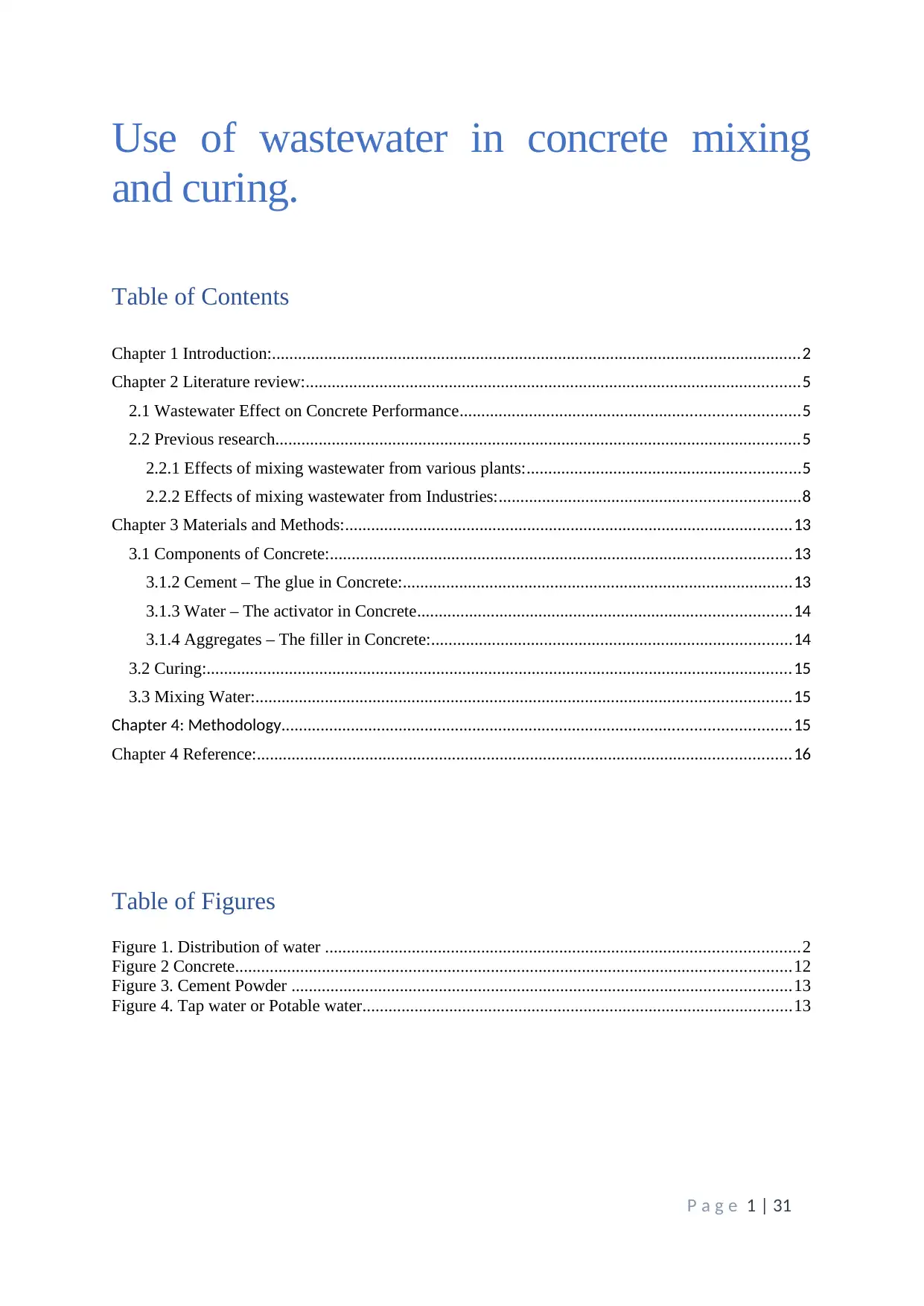
Use of wastewater in concrete mixing
and curing.
Table of Contents
Chapter 1 Introduction:..........................................................................................................................2
Chapter 2 Literature review:..................................................................................................................5
2.1 Wastewater Effect on Concrete Performance..............................................................................5
2.2 Previous research.........................................................................................................................5
2.2.1 Effects of mixing wastewater from various plants:...............................................................5
2.2.2 Effects of mixing wastewater from Industries:.....................................................................8
Chapter 3 Materials and Methods:.......................................................................................................13
3.1 Components of Concrete:..........................................................................................................13
3.1.2 Cement – The glue in Concrete:..........................................................................................13
3.1.3 Water – The activator in Concrete......................................................................................14
3.1.4 Aggregates – The filler in Concrete:...................................................................................14
3.2 Curing:.......................................................................................................................................15
3.3 Mixing Water:...........................................................................................................................15
Chapter 4: Methodology.....................................................................................................................15
Chapter 4 Reference:...........................................................................................................................16
Table of Figures
Figure 1. Distribution of water .............................................................................................................2
Figure 2 Concrete................................................................................................................................12
Figure 3. Cement Powder ...................................................................................................................13
Figure 4. Tap water or Potable water...................................................................................................13
P a g e 1 | 31
and curing.
Table of Contents
Chapter 1 Introduction:..........................................................................................................................2
Chapter 2 Literature review:..................................................................................................................5
2.1 Wastewater Effect on Concrete Performance..............................................................................5
2.2 Previous research.........................................................................................................................5
2.2.1 Effects of mixing wastewater from various plants:...............................................................5
2.2.2 Effects of mixing wastewater from Industries:.....................................................................8
Chapter 3 Materials and Methods:.......................................................................................................13
3.1 Components of Concrete:..........................................................................................................13
3.1.2 Cement – The glue in Concrete:..........................................................................................13
3.1.3 Water – The activator in Concrete......................................................................................14
3.1.4 Aggregates – The filler in Concrete:...................................................................................14
3.2 Curing:.......................................................................................................................................15
3.3 Mixing Water:...........................................................................................................................15
Chapter 4: Methodology.....................................................................................................................15
Chapter 4 Reference:...........................................................................................................................16
Table of Figures
Figure 1. Distribution of water .............................................................................................................2
Figure 2 Concrete................................................................................................................................12
Figure 3. Cement Powder ...................................................................................................................13
Figure 4. Tap water or Potable water...................................................................................................13
P a g e 1 | 31
Secure Best Marks with AI Grader
Need help grading? Try our AI Grader for instant feedback on your assignments.
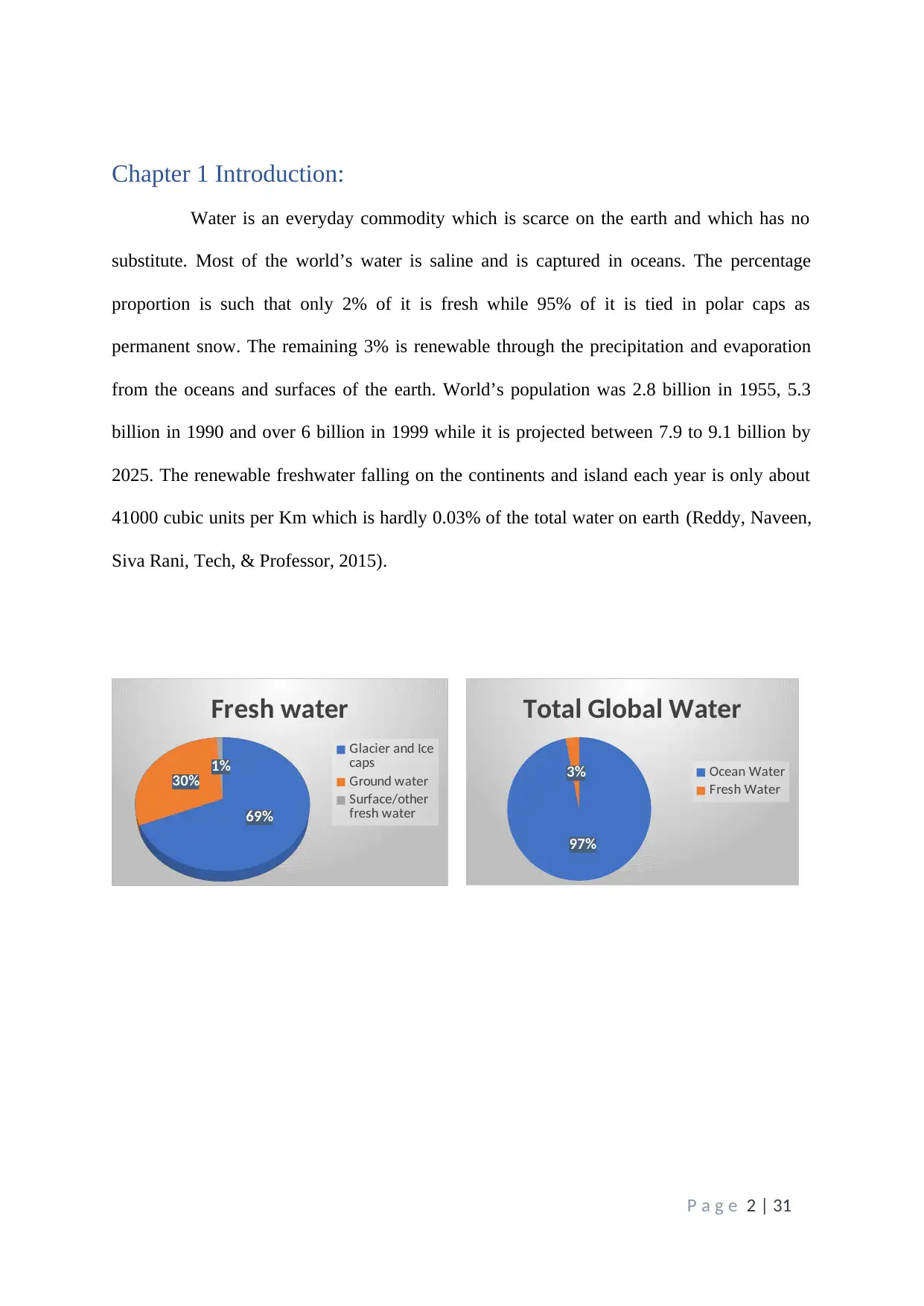
Chapter 1 Introduction:
Water is an everyday commodity which is scarce on the earth and which has no
substitute. Most of the world’s water is saline and is captured in oceans. The percentage
proportion is such that only 2% of it is fresh while 95% of it is tied in polar caps as
permanent snow. The remaining 3% is renewable through the precipitation and evaporation
from the oceans and surfaces of the earth. World’s population was 2.8 billion in 1955, 5.3
billion in 1990 and over 6 billion in 1999 while it is projected between 7.9 to 9.1 billion by
2025. The renewable freshwater falling on the continents and island each year is only about
41000 cubic units per Km which is hardly 0.03% of the total water on earth (Reddy, Naveen,
Siva Rani, Tech, & Professor, 2015).
69%
30% 1%
Fresh water
Glacier and Ice
caps
Ground water
Surface/other
fresh water
97%
3%
Total Global Water
Ocean Water
Fresh Water
P a g e 2 | 31
Water is an everyday commodity which is scarce on the earth and which has no
substitute. Most of the world’s water is saline and is captured in oceans. The percentage
proportion is such that only 2% of it is fresh while 95% of it is tied in polar caps as
permanent snow. The remaining 3% is renewable through the precipitation and evaporation
from the oceans and surfaces of the earth. World’s population was 2.8 billion in 1955, 5.3
billion in 1990 and over 6 billion in 1999 while it is projected between 7.9 to 9.1 billion by
2025. The renewable freshwater falling on the continents and island each year is only about
41000 cubic units per Km which is hardly 0.03% of the total water on earth (Reddy, Naveen,
Siva Rani, Tech, & Professor, 2015).
69%
30% 1%
Fresh water
Glacier and Ice
caps
Ground water
Surface/other
fresh water
97%
3%
Total Global Water
Ocean Water
Fresh Water
P a g e 2 | 31
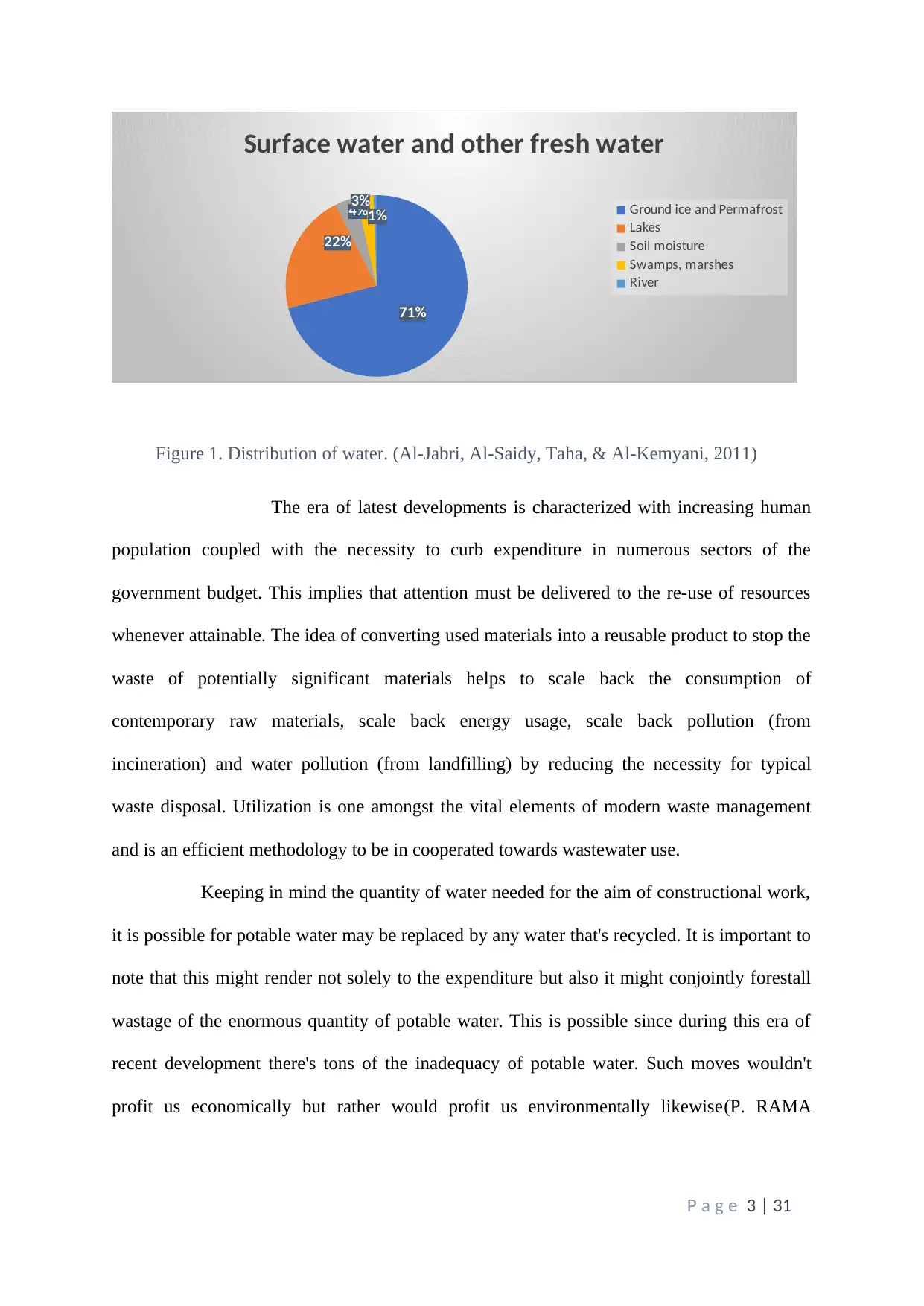
71%
22%
4%
3%1%
Surface water and other fresh water
Ground ice and Permafrost
Lakes
Soil moisture
Swamps, marshes
River
Figure 1. Distribution of water. (Al-Jabri, Al-Saidy, Taha, & Al-Kemyani, 2011)
The era of latest developments is characterized with increasing human
population coupled with the necessity to curb expenditure in numerous sectors of the
government budget. This implies that attention must be delivered to the re-use of resources
whenever attainable. The idea of converting used materials into a reusable product to stop the
waste of potentially significant materials helps to scale back the consumption of
contemporary raw materials, scale back energy usage, scale back pollution (from
incineration) and water pollution (from landfilling) by reducing the necessity for typical
waste disposal. Utilization is one amongst the vital elements of modern waste management
and is an efficient methodology to be in cooperated towards wastewater use.
Keeping in mind the quantity of water needed for the aim of constructional work,
it is possible for potable water may be replaced by any water that's recycled. It is important to
note that this might render not solely to the expenditure but also it might conjointly forestall
wastage of the enormous quantity of potable water. This is possible since during this era of
recent development there's tons of the inadequacy of potable water. Such moves wouldn't
profit us economically but rather would profit us environmentally likewise(P. RAMA
P a g e 3 | 31
22%
4%
3%1%
Surface water and other fresh water
Ground ice and Permafrost
Lakes
Soil moisture
Swamps, marshes
River
Figure 1. Distribution of water. (Al-Jabri, Al-Saidy, Taha, & Al-Kemyani, 2011)
The era of latest developments is characterized with increasing human
population coupled with the necessity to curb expenditure in numerous sectors of the
government budget. This implies that attention must be delivered to the re-use of resources
whenever attainable. The idea of converting used materials into a reusable product to stop the
waste of potentially significant materials helps to scale back the consumption of
contemporary raw materials, scale back energy usage, scale back pollution (from
incineration) and water pollution (from landfilling) by reducing the necessity for typical
waste disposal. Utilization is one amongst the vital elements of modern waste management
and is an efficient methodology to be in cooperated towards wastewater use.
Keeping in mind the quantity of water needed for the aim of constructional work,
it is possible for potable water may be replaced by any water that's recycled. It is important to
note that this might render not solely to the expenditure but also it might conjointly forestall
wastage of the enormous quantity of potable water. This is possible since during this era of
recent development there's tons of the inadequacy of potable water. Such moves wouldn't
profit us economically but rather would profit us environmentally likewise(P. RAMA
P a g e 3 | 31
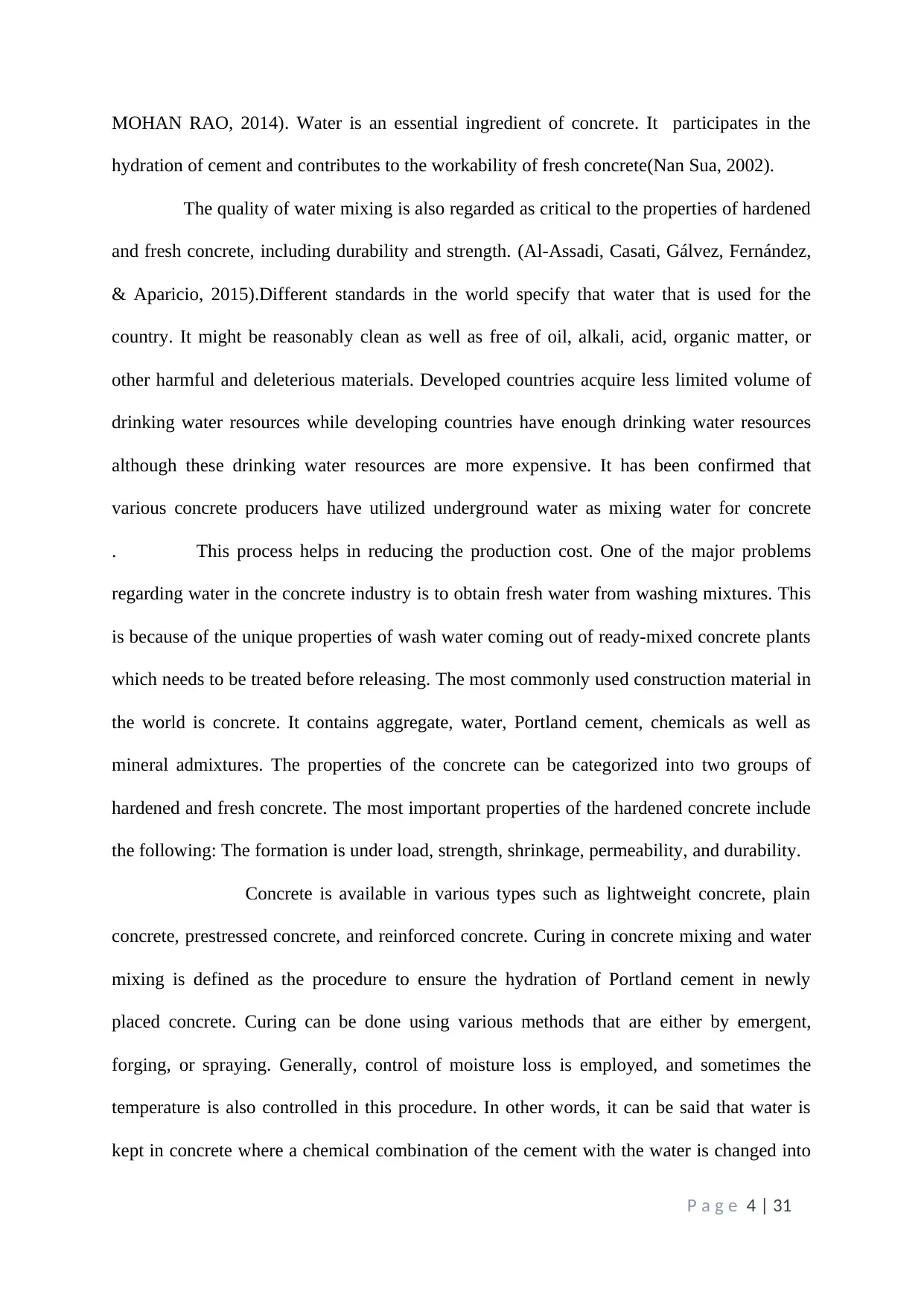
MOHAN RAO, 2014). Water is an essential ingredient of concrete. It participates in the
hydration of cement and contributes to the workability of fresh concrete(Nan Sua, 2002).
The quality of water mixing is also regarded as critical to the properties of hardened
and fresh concrete, including durability and strength. (Al-Assadi, Casati, Gálvez, Fernández,
& Aparicio, 2015).Different standards in the world specify that water that is used for the
country. It might be reasonably clean as well as free of oil, alkali, acid, organic matter, or
other harmful and deleterious materials. Developed countries acquire less limited volume of
drinking water resources while developing countries have enough drinking water resources
although these drinking water resources are more expensive. It has been confirmed that
various concrete producers have utilized underground water as mixing water for concrete
. This process helps in reducing the production cost. One of the major problems
regarding water in the concrete industry is to obtain fresh water from washing mixtures. This
is because of the unique properties of wash water coming out of ready-mixed concrete plants
which needs to be treated before releasing. The most commonly used construction material in
the world is concrete. It contains aggregate, water, Portland cement, chemicals as well as
mineral admixtures. The properties of the concrete can be categorized into two groups of
hardened and fresh concrete. The most important properties of the hardened concrete include
the following: The formation is under load, strength, shrinkage, permeability, and durability.
Concrete is available in various types such as lightweight concrete, plain
concrete, prestressed concrete, and reinforced concrete. Curing in concrete mixing and water
mixing is defined as the procedure to ensure the hydration of Portland cement in newly
placed concrete. Curing can be done using various methods that are either by emergent,
forging, or spraying. Generally, control of moisture loss is employed, and sometimes the
temperature is also controlled in this procedure. In other words, it can be said that water is
kept in concrete where a chemical combination of the cement with the water is changed into
P a g e 4 | 31
hydration of cement and contributes to the workability of fresh concrete(Nan Sua, 2002).
The quality of water mixing is also regarded as critical to the properties of hardened
and fresh concrete, including durability and strength. (Al-Assadi, Casati, Gálvez, Fernández,
& Aparicio, 2015).Different standards in the world specify that water that is used for the
country. It might be reasonably clean as well as free of oil, alkali, acid, organic matter, or
other harmful and deleterious materials. Developed countries acquire less limited volume of
drinking water resources while developing countries have enough drinking water resources
although these drinking water resources are more expensive. It has been confirmed that
various concrete producers have utilized underground water as mixing water for concrete
. This process helps in reducing the production cost. One of the major problems
regarding water in the concrete industry is to obtain fresh water from washing mixtures. This
is because of the unique properties of wash water coming out of ready-mixed concrete plants
which needs to be treated before releasing. The most commonly used construction material in
the world is concrete. It contains aggregate, water, Portland cement, chemicals as well as
mineral admixtures. The properties of the concrete can be categorized into two groups of
hardened and fresh concrete. The most important properties of the hardened concrete include
the following: The formation is under load, strength, shrinkage, permeability, and durability.
Concrete is available in various types such as lightweight concrete, plain
concrete, prestressed concrete, and reinforced concrete. Curing in concrete mixing and water
mixing is defined as the procedure to ensure the hydration of Portland cement in newly
placed concrete. Curing can be done using various methods that are either by emergent,
forging, or spraying. Generally, control of moisture loss is employed, and sometimes the
temperature is also controlled in this procedure. In other words, it can be said that water is
kept in concrete where a chemical combination of the cement with the water is changed into
P a g e 4 | 31
Secure Best Marks with AI Grader
Need help grading? Try our AI Grader for instant feedback on your assignments.
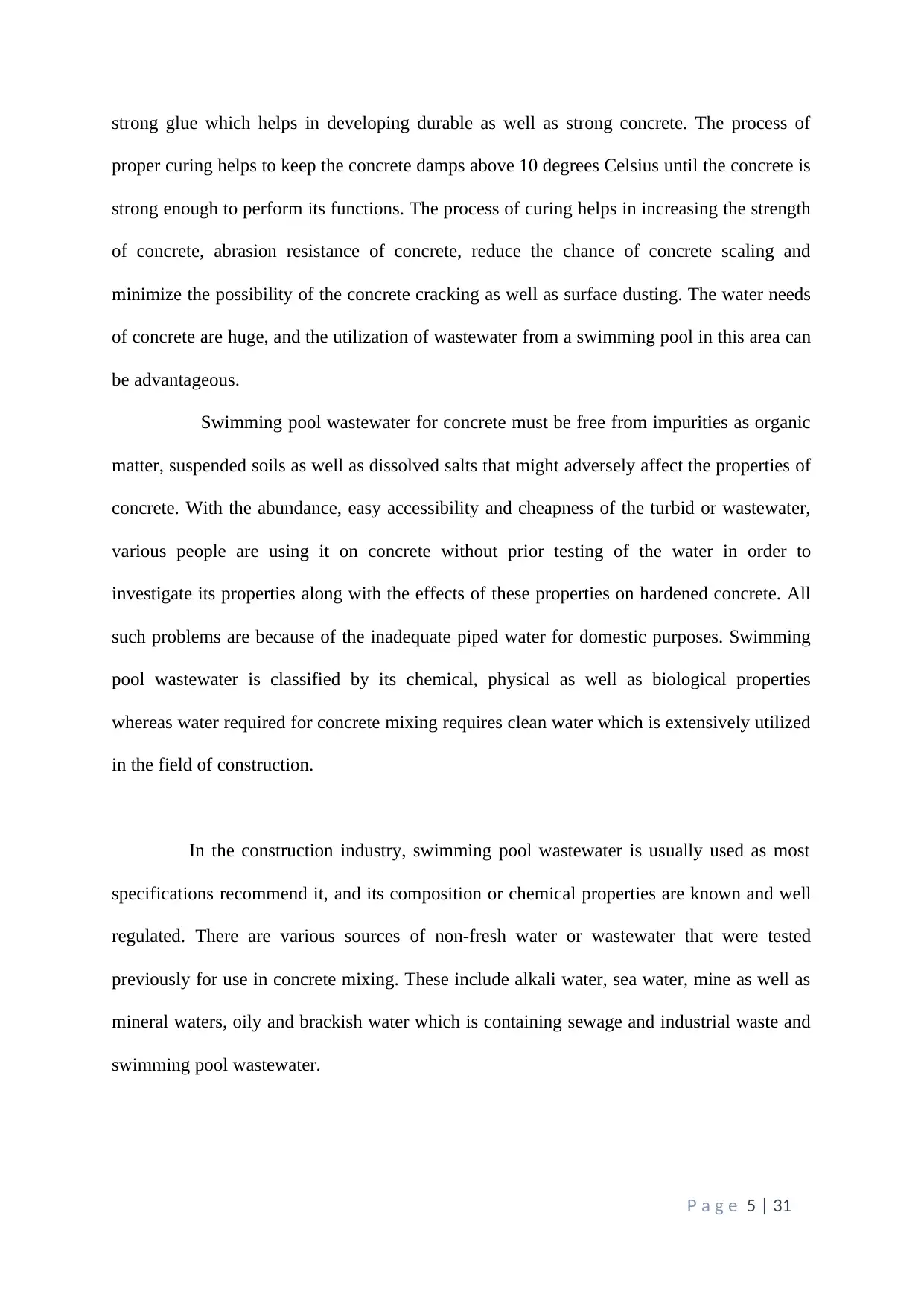
strong glue which helps in developing durable as well as strong concrete. The process of
proper curing helps to keep the concrete damps above 10 degrees Celsius until the concrete is
strong enough to perform its functions. The process of curing helps in increasing the strength
of concrete, abrasion resistance of concrete, reduce the chance of concrete scaling and
minimize the possibility of the concrete cracking as well as surface dusting. The water needs
of concrete are huge, and the utilization of wastewater from a swimming pool in this area can
be advantageous.
Swimming pool wastewater for concrete must be free from impurities as organic
matter, suspended soils as well as dissolved salts that might adversely affect the properties of
concrete. With the abundance, easy accessibility and cheapness of the turbid or wastewater,
various people are using it on concrete without prior testing of the water in order to
investigate its properties along with the effects of these properties on hardened concrete. All
such problems are because of the inadequate piped water for domestic purposes. Swimming
pool wastewater is classified by its chemical, physical as well as biological properties
whereas water required for concrete mixing requires clean water which is extensively utilized
in the field of construction.
In the construction industry, swimming pool wastewater is usually used as most
specifications recommend it, and its composition or chemical properties are known and well
regulated. There are various sources of non-fresh water or wastewater that were tested
previously for use in concrete mixing. These include alkali water, sea water, mine as well as
mineral waters, oily and brackish water which is containing sewage and industrial waste and
swimming pool wastewater.
P a g e 5 | 31
proper curing helps to keep the concrete damps above 10 degrees Celsius until the concrete is
strong enough to perform its functions. The process of curing helps in increasing the strength
of concrete, abrasion resistance of concrete, reduce the chance of concrete scaling and
minimize the possibility of the concrete cracking as well as surface dusting. The water needs
of concrete are huge, and the utilization of wastewater from a swimming pool in this area can
be advantageous.
Swimming pool wastewater for concrete must be free from impurities as organic
matter, suspended soils as well as dissolved salts that might adversely affect the properties of
concrete. With the abundance, easy accessibility and cheapness of the turbid or wastewater,
various people are using it on concrete without prior testing of the water in order to
investigate its properties along with the effects of these properties on hardened concrete. All
such problems are because of the inadequate piped water for domestic purposes. Swimming
pool wastewater is classified by its chemical, physical as well as biological properties
whereas water required for concrete mixing requires clean water which is extensively utilized
in the field of construction.
In the construction industry, swimming pool wastewater is usually used as most
specifications recommend it, and its composition or chemical properties are known and well
regulated. There are various sources of non-fresh water or wastewater that were tested
previously for use in concrete mixing. These include alkali water, sea water, mine as well as
mineral waters, oily and brackish water which is containing sewage and industrial waste and
swimming pool wastewater.
P a g e 5 | 31
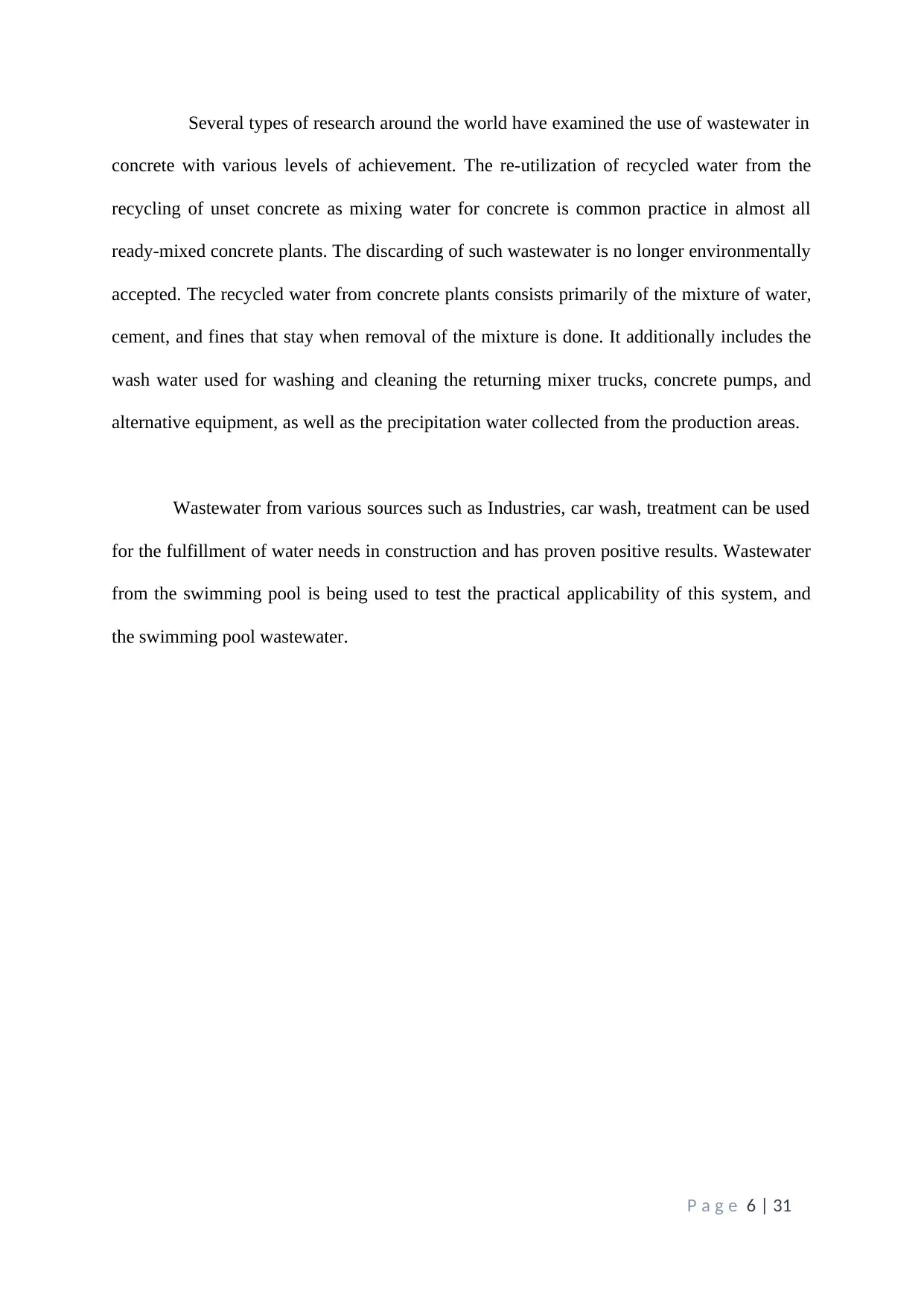
Several types of research around the world have examined the use of wastewater in
concrete with various levels of achievement. The re-utilization of recycled water from the
recycling of unset concrete as mixing water for concrete is common practice in almost all
ready-mixed concrete plants. The discarding of such wastewater is no longer environmentally
accepted. The recycled water from concrete plants consists primarily of the mixture of water,
cement, and fines that stay when removal of the mixture is done. It additionally includes the
wash water used for washing and cleaning the returning mixer trucks, concrete pumps, and
alternative equipment, as well as the precipitation water collected from the production areas.
Wastewater from various sources such as Industries, car wash, treatment can be used
for the fulfillment of water needs in construction and has proven positive results. Wastewater
from the swimming pool is being used to test the practical applicability of this system, and
the swimming pool wastewater.
P a g e 6 | 31
concrete with various levels of achievement. The re-utilization of recycled water from the
recycling of unset concrete as mixing water for concrete is common practice in almost all
ready-mixed concrete plants. The discarding of such wastewater is no longer environmentally
accepted. The recycled water from concrete plants consists primarily of the mixture of water,
cement, and fines that stay when removal of the mixture is done. It additionally includes the
wash water used for washing and cleaning the returning mixer trucks, concrete pumps, and
alternative equipment, as well as the precipitation water collected from the production areas.
Wastewater from various sources such as Industries, car wash, treatment can be used
for the fulfillment of water needs in construction and has proven positive results. Wastewater
from the swimming pool is being used to test the practical applicability of this system, and
the swimming pool wastewater.
P a g e 6 | 31
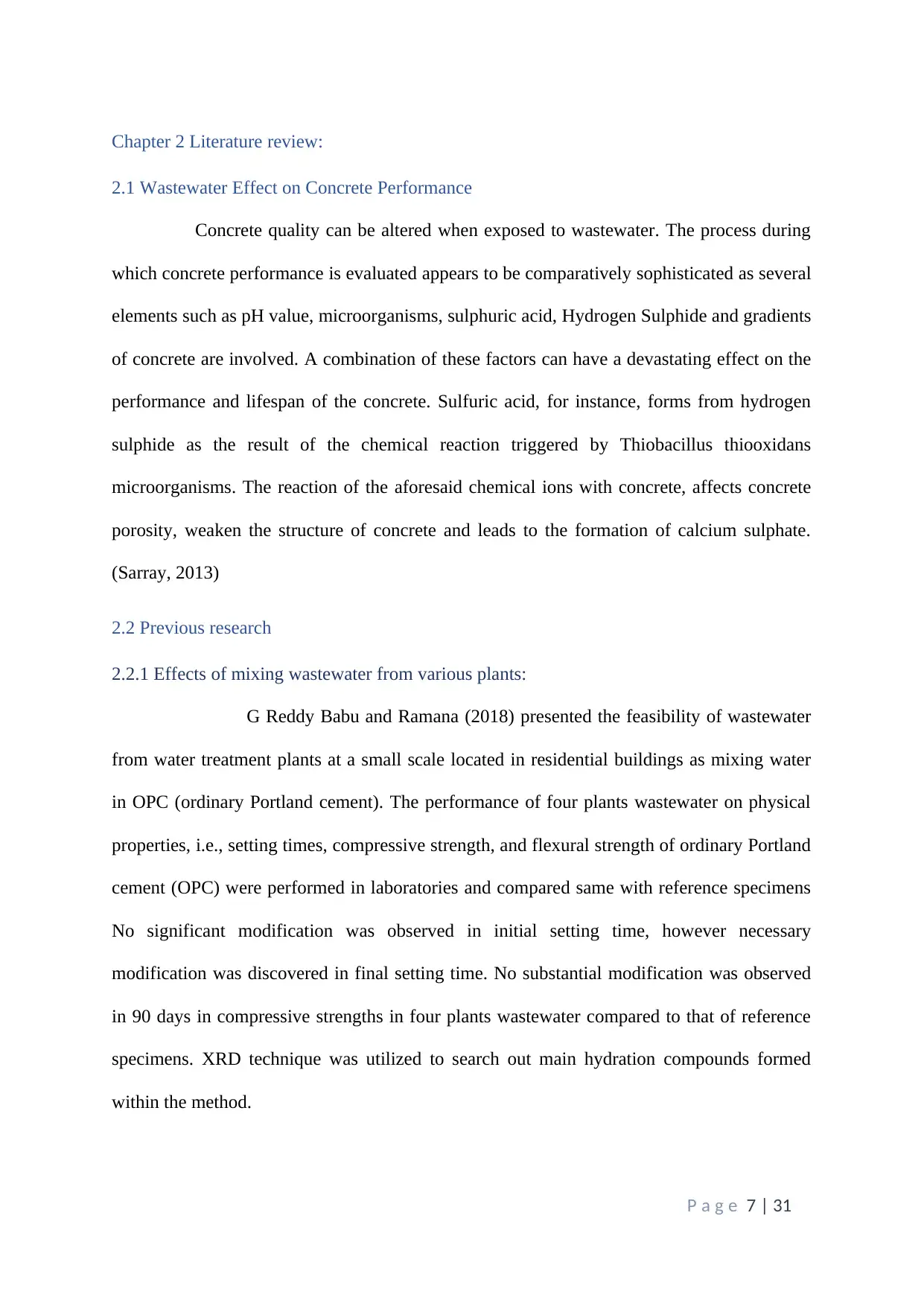
Chapter 2 Literature review:
2.1 Wastewater Effect on Concrete Performance
Concrete quality can be altered when exposed to wastewater. The process during
which concrete performance is evaluated appears to be comparatively sophisticated as several
elements such as pH value, microorganisms, sulphuric acid, Hydrogen Sulphide and gradients
of concrete are involved. A combination of these factors can have a devastating effect on the
performance and lifespan of the concrete. Sulfuric acid, for instance, forms from hydrogen
sulphide as the result of the chemical reaction triggered by Thiobacillus thiooxidans
microorganisms. The reaction of the aforesaid chemical ions with concrete, affects concrete
porosity, weaken the structure of concrete and leads to the formation of calcium sulphate.
(Sarray, 2013)
2.2 Previous research
2.2.1 Effects of mixing wastewater from various plants:
G Reddy Babu and Ramana (2018) presented the feasibility of wastewater
from water treatment plants at a small scale located in residential buildings as mixing water
in OPC (ordinary Portland cement). The performance of four plants wastewater on physical
properties, i.e., setting times, compressive strength, and flexural strength of ordinary Portland
cement (OPC) were performed in laboratories and compared same with reference specimens
No significant modification was observed in initial setting time, however necessary
modification was discovered in final setting time. No substantial modification was observed
in 90 days in compressive strengths in four plants wastewater compared to that of reference
specimens. XRD technique was utilized to search out main hydration compounds formed
within the method.
P a g e 7 | 31
2.1 Wastewater Effect on Concrete Performance
Concrete quality can be altered when exposed to wastewater. The process during
which concrete performance is evaluated appears to be comparatively sophisticated as several
elements such as pH value, microorganisms, sulphuric acid, Hydrogen Sulphide and gradients
of concrete are involved. A combination of these factors can have a devastating effect on the
performance and lifespan of the concrete. Sulfuric acid, for instance, forms from hydrogen
sulphide as the result of the chemical reaction triggered by Thiobacillus thiooxidans
microorganisms. The reaction of the aforesaid chemical ions with concrete, affects concrete
porosity, weaken the structure of concrete and leads to the formation of calcium sulphate.
(Sarray, 2013)
2.2 Previous research
2.2.1 Effects of mixing wastewater from various plants:
G Reddy Babu and Ramana (2018) presented the feasibility of wastewater
from water treatment plants at a small scale located in residential buildings as mixing water
in OPC (ordinary Portland cement). The performance of four plants wastewater on physical
properties, i.e., setting times, compressive strength, and flexural strength of ordinary Portland
cement (OPC) were performed in laboratories and compared same with reference specimens
No significant modification was observed in initial setting time, however necessary
modification was discovered in final setting time. No substantial modification was observed
in 90 days in compressive strengths in four plants wastewater compared to that of reference
specimens. XRD technique was utilized to search out main hydration compounds formed
within the method.
P a g e 7 | 31
Paraphrase This Document
Need a fresh take? Get an instant paraphrase of this document with our AI Paraphraser
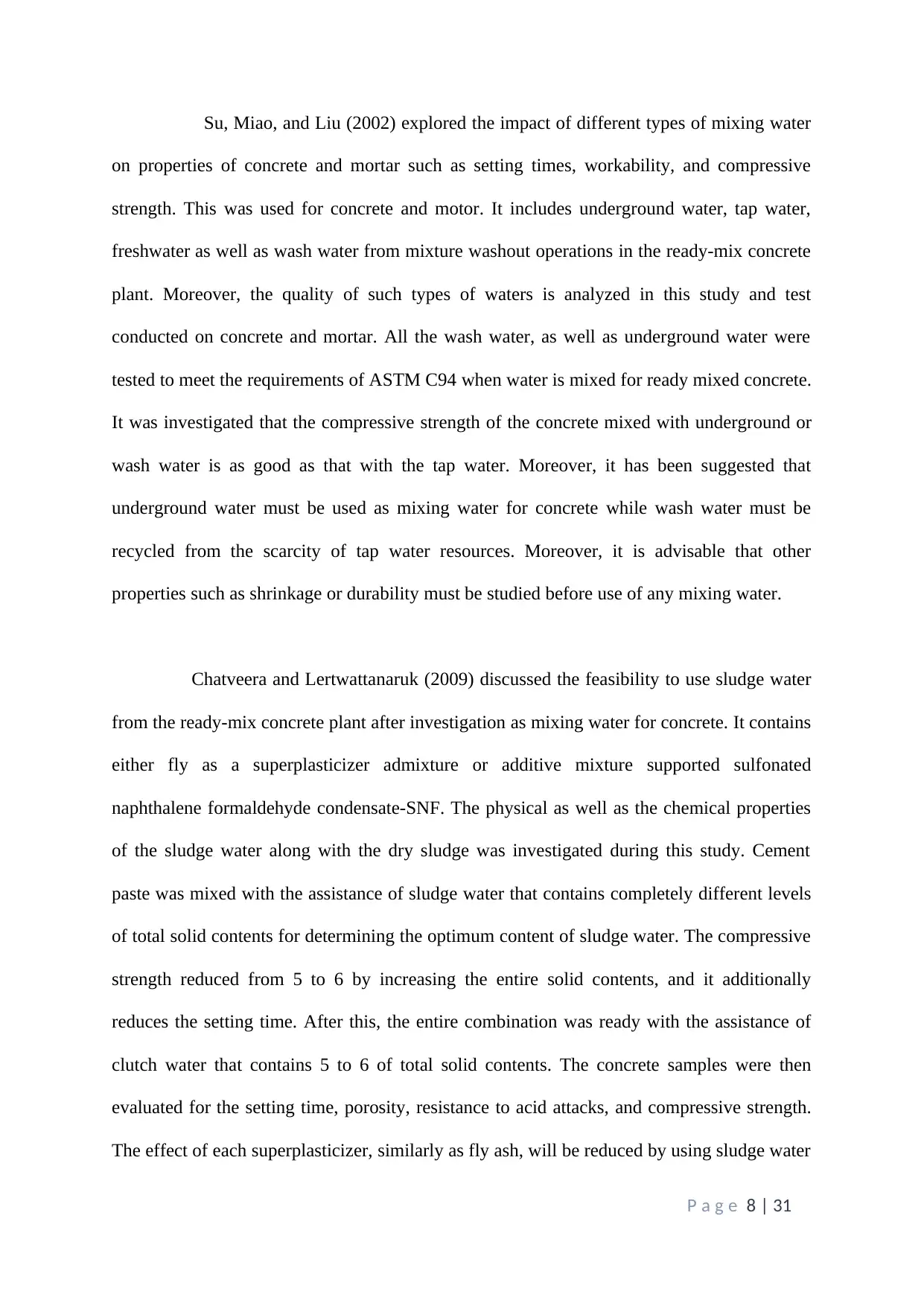
Su, Miao, and Liu (2002) explored the impact of different types of mixing water
on properties of concrete and mortar such as setting times, workability, and compressive
strength. This was used for concrete and motor. It includes underground water, tap water,
freshwater as well as wash water from mixture washout operations in the ready-mix concrete
plant. Moreover, the quality of such types of waters is analyzed in this study and test
conducted on concrete and mortar. All the wash water, as well as underground water were
tested to meet the requirements of ASTM C94 when water is mixed for ready mixed concrete.
It was investigated that the compressive strength of the concrete mixed with underground or
wash water is as good as that with the tap water. Moreover, it has been suggested that
underground water must be used as mixing water for concrete while wash water must be
recycled from the scarcity of tap water resources. Moreover, it is advisable that other
properties such as shrinkage or durability must be studied before use of any mixing water.
Chatveera and Lertwattanaruk (2009) discussed the feasibility to use sludge water
from the ready-mix concrete plant after investigation as mixing water for concrete. It contains
either fly as a superplasticizer admixture or additive mixture supported sulfonated
naphthalene formaldehyde condensate-SNF. The physical as well as the chemical properties
of the sludge water along with the dry sludge was investigated during this study. Cement
paste was mixed with the assistance of sludge water that contains completely different levels
of total solid contents for determining the optimum content of sludge water. The compressive
strength reduced from 5 to 6 by increasing the entire solid contents, and it additionally
reduces the setting time. After this, the entire combination was ready with the assistance of
clutch water that contains 5 to 6 of total solid contents. The concrete samples were then
evaluated for the setting time, porosity, resistance to acid attacks, and compressive strength.
The effect of each superplasticizer, similarly as fly ash, will be reduced by using sludge water
P a g e 8 | 31
on properties of concrete and mortar such as setting times, workability, and compressive
strength. This was used for concrete and motor. It includes underground water, tap water,
freshwater as well as wash water from mixture washout operations in the ready-mix concrete
plant. Moreover, the quality of such types of waters is analyzed in this study and test
conducted on concrete and mortar. All the wash water, as well as underground water were
tested to meet the requirements of ASTM C94 when water is mixed for ready mixed concrete.
It was investigated that the compressive strength of the concrete mixed with underground or
wash water is as good as that with the tap water. Moreover, it has been suggested that
underground water must be used as mixing water for concrete while wash water must be
recycled from the scarcity of tap water resources. Moreover, it is advisable that other
properties such as shrinkage or durability must be studied before use of any mixing water.
Chatveera and Lertwattanaruk (2009) discussed the feasibility to use sludge water
from the ready-mix concrete plant after investigation as mixing water for concrete. It contains
either fly as a superplasticizer admixture or additive mixture supported sulfonated
naphthalene formaldehyde condensate-SNF. The physical as well as the chemical properties
of the sludge water along with the dry sludge was investigated during this study. Cement
paste was mixed with the assistance of sludge water that contains completely different levels
of total solid contents for determining the optimum content of sludge water. The compressive
strength reduced from 5 to 6 by increasing the entire solid contents, and it additionally
reduces the setting time. After this, the entire combination was ready with the assistance of
clutch water that contains 5 to 6 of total solid contents. The concrete samples were then
evaluated for the setting time, porosity, resistance to acid attacks, and compressive strength.
The effect of each superplasticizer, similarly as fly ash, will be reduced by using sludge water
P a g e 8 | 31
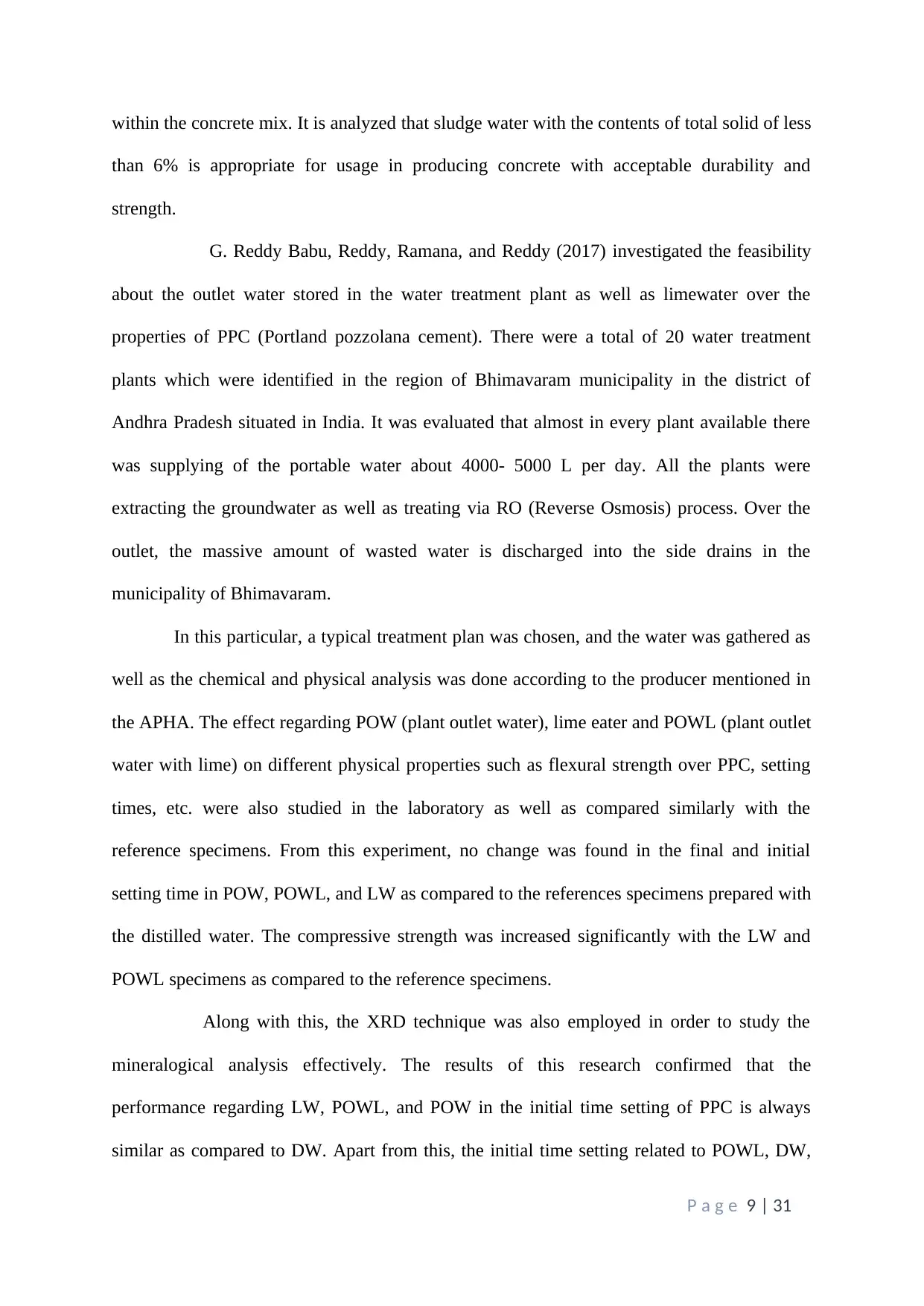
within the concrete mix. It is analyzed that sludge water with the contents of total solid of less
than 6% is appropriate for usage in producing concrete with acceptable durability and
strength.
G. Reddy Babu, Reddy, Ramana, and Reddy (2017) investigated the feasibility
about the outlet water stored in the water treatment plant as well as limewater over the
properties of PPC (Portland pozzolana cement). There were a total of 20 water treatment
plants which were identified in the region of Bhimavaram municipality in the district of
Andhra Pradesh situated in India. It was evaluated that almost in every plant available there
was supplying of the portable water about 4000- 5000 L per day. All the plants were
extracting the groundwater as well as treating via RO (Reverse Osmosis) process. Over the
outlet, the massive amount of wasted water is discharged into the side drains in the
municipality of Bhimavaram.
In this particular, a typical treatment plan was chosen, and the water was gathered as
well as the chemical and physical analysis was done according to the producer mentioned in
the APHA. The effect regarding POW (plant outlet water), lime eater and POWL (plant outlet
water with lime) on different physical properties such as flexural strength over PPC, setting
times, etc. were also studied in the laboratory as well as compared similarly with the
reference specimens. From this experiment, no change was found in the final and initial
setting time in POW, POWL, and LW as compared to the references specimens prepared with
the distilled water. The compressive strength was increased significantly with the LW and
POWL specimens as compared to the reference specimens.
Along with this, the XRD technique was also employed in order to study the
mineralogical analysis effectively. The results of this research confirmed that the
performance regarding LW, POWL, and POW in the initial time setting of PPC is always
similar as compared to DW. Apart from this, the initial time setting related to POWL, DW,
P a g e 9 | 31
than 6% is appropriate for usage in producing concrete with acceptable durability and
strength.
G. Reddy Babu, Reddy, Ramana, and Reddy (2017) investigated the feasibility
about the outlet water stored in the water treatment plant as well as limewater over the
properties of PPC (Portland pozzolana cement). There were a total of 20 water treatment
plants which were identified in the region of Bhimavaram municipality in the district of
Andhra Pradesh situated in India. It was evaluated that almost in every plant available there
was supplying of the portable water about 4000- 5000 L per day. All the plants were
extracting the groundwater as well as treating via RO (Reverse Osmosis) process. Over the
outlet, the massive amount of wasted water is discharged into the side drains in the
municipality of Bhimavaram.
In this particular, a typical treatment plan was chosen, and the water was gathered as
well as the chemical and physical analysis was done according to the producer mentioned in
the APHA. The effect regarding POW (plant outlet water), lime eater and POWL (plant outlet
water with lime) on different physical properties such as flexural strength over PPC, setting
times, etc. were also studied in the laboratory as well as compared similarly with the
reference specimens. From this experiment, no change was found in the final and initial
setting time in POW, POWL, and LW as compared to the references specimens prepared with
the distilled water. The compressive strength was increased significantly with the LW and
POWL specimens as compared to the reference specimens.
Along with this, the XRD technique was also employed in order to study the
mineralogical analysis effectively. The results of this research confirmed that the
performance regarding LW, POWL, and POW in the initial time setting of PPC is always
similar as compared to DW. Apart from this, the initial time setting related to POWL, DW,
P a g e 9 | 31
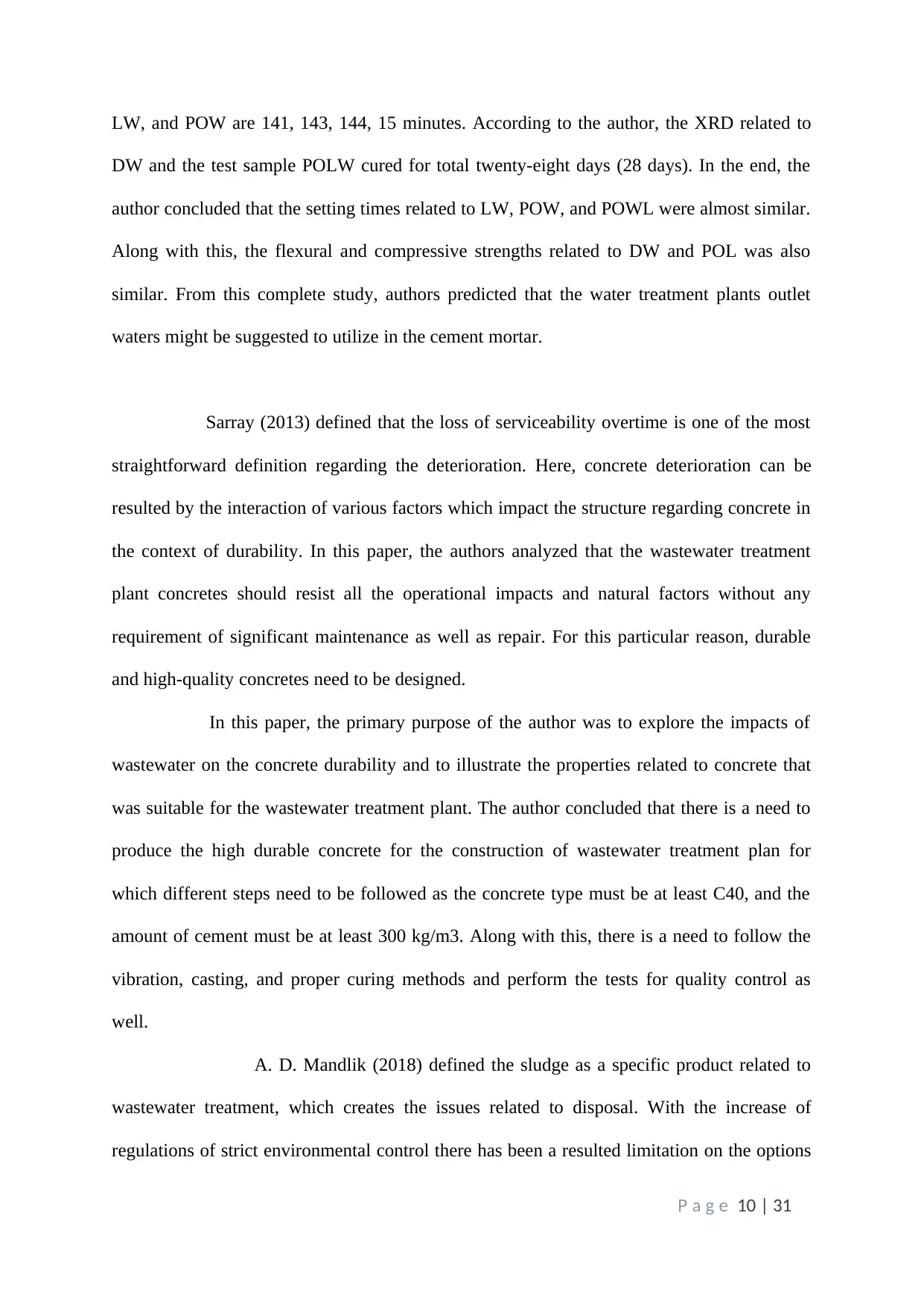
LW, and POW are 141, 143, 144, 15 minutes. According to the author, the XRD related to
DW and the test sample POLW cured for total twenty-eight days (28 days). In the end, the
author concluded that the setting times related to LW, POW, and POWL were almost similar.
Along with this, the flexural and compressive strengths related to DW and POL was also
similar. From this complete study, authors predicted that the water treatment plants outlet
waters might be suggested to utilize in the cement mortar.
Sarray (2013) defined that the loss of serviceability overtime is one of the most
straightforward definition regarding the deterioration. Here, concrete deterioration can be
resulted by the interaction of various factors which impact the structure regarding concrete in
the context of durability. In this paper, the authors analyzed that the wastewater treatment
plant concretes should resist all the operational impacts and natural factors without any
requirement of significant maintenance as well as repair. For this particular reason, durable
and high-quality concretes need to be designed.
In this paper, the primary purpose of the author was to explore the impacts of
wastewater on the concrete durability and to illustrate the properties related to concrete that
was suitable for the wastewater treatment plant. The author concluded that there is a need to
produce the high durable concrete for the construction of wastewater treatment plan for
which different steps need to be followed as the concrete type must be at least C40, and the
amount of cement must be at least 300 kg/m3. Along with this, there is a need to follow the
vibration, casting, and proper curing methods and perform the tests for quality control as
well.
A. D. Mandlik (2018) defined the sludge as a specific product related to
wastewater treatment, which creates the issues related to disposal. With the increase of
regulations of strict environmental control there has been a resulted limitation on the options
P a g e 10 | 31
DW and the test sample POLW cured for total twenty-eight days (28 days). In the end, the
author concluded that the setting times related to LW, POW, and POWL were almost similar.
Along with this, the flexural and compressive strengths related to DW and POL was also
similar. From this complete study, authors predicted that the water treatment plants outlet
waters might be suggested to utilize in the cement mortar.
Sarray (2013) defined that the loss of serviceability overtime is one of the most
straightforward definition regarding the deterioration. Here, concrete deterioration can be
resulted by the interaction of various factors which impact the structure regarding concrete in
the context of durability. In this paper, the authors analyzed that the wastewater treatment
plant concretes should resist all the operational impacts and natural factors without any
requirement of significant maintenance as well as repair. For this particular reason, durable
and high-quality concretes need to be designed.
In this paper, the primary purpose of the author was to explore the impacts of
wastewater on the concrete durability and to illustrate the properties related to concrete that
was suitable for the wastewater treatment plant. The author concluded that there is a need to
produce the high durable concrete for the construction of wastewater treatment plan for
which different steps need to be followed as the concrete type must be at least C40, and the
amount of cement must be at least 300 kg/m3. Along with this, there is a need to follow the
vibration, casting, and proper curing methods and perform the tests for quality control as
well.
A. D. Mandlik (2018) defined the sludge as a specific product related to
wastewater treatment, which creates the issues related to disposal. With the increase of
regulations of strict environmental control there has been a resulted limitation on the options
P a g e 10 | 31
Secure Best Marks with AI Grader
Need help grading? Try our AI Grader for instant feedback on your assignments.
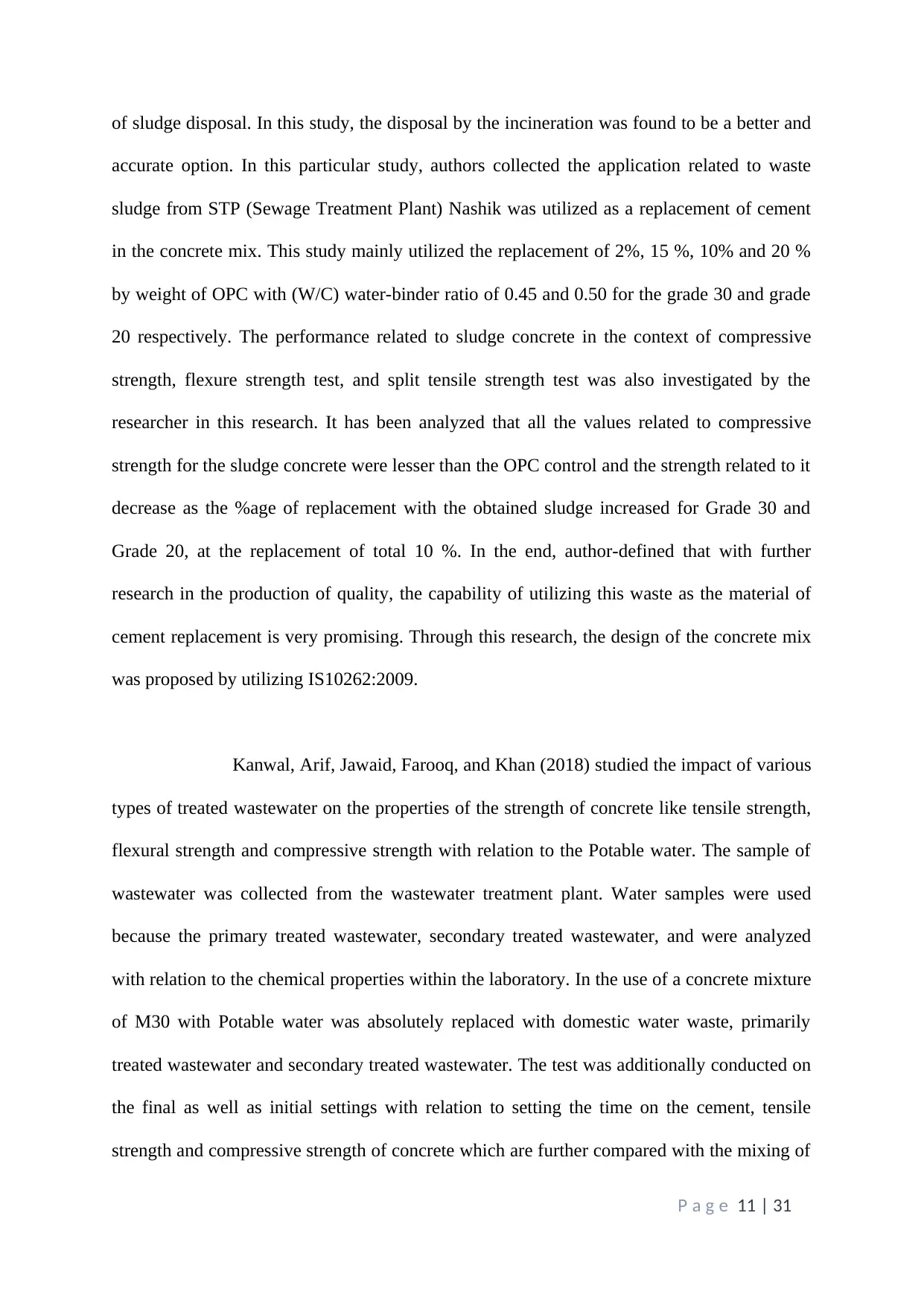
of sludge disposal. In this study, the disposal by the incineration was found to be a better and
accurate option. In this particular study, authors collected the application related to waste
sludge from STP (Sewage Treatment Plant) Nashik was utilized as a replacement of cement
in the concrete mix. This study mainly utilized the replacement of 2%, 15 %, 10% and 20 %
by weight of OPC with (W/C) water-binder ratio of 0.45 and 0.50 for the grade 30 and grade
20 respectively. The performance related to sludge concrete in the context of compressive
strength, flexure strength test, and split tensile strength test was also investigated by the
researcher in this research. It has been analyzed that all the values related to compressive
strength for the sludge concrete were lesser than the OPC control and the strength related to it
decrease as the %age of replacement with the obtained sludge increased for Grade 30 and
Grade 20, at the replacement of total 10 %. In the end, author-defined that with further
research in the production of quality, the capability of utilizing this waste as the material of
cement replacement is very promising. Through this research, the design of the concrete mix
was proposed by utilizing IS10262:2009.
Kanwal, Arif, Jawaid, Farooq, and Khan (2018) studied the impact of various
types of treated wastewater on the properties of the strength of concrete like tensile strength,
flexural strength and compressive strength with relation to the Potable water. The sample of
wastewater was collected from the wastewater treatment plant. Water samples were used
because the primary treated wastewater, secondary treated wastewater, and were analyzed
with relation to the chemical properties within the laboratory. In the use of a concrete mixture
of M30 with Potable water was absolutely replaced with domestic water waste, primarily
treated wastewater and secondary treated wastewater. The test was additionally conducted on
the final as well as initial settings with relation to setting the time on the cement, tensile
strength and compressive strength of concrete which are further compared with the mixing of
P a g e 11 | 31
accurate option. In this particular study, authors collected the application related to waste
sludge from STP (Sewage Treatment Plant) Nashik was utilized as a replacement of cement
in the concrete mix. This study mainly utilized the replacement of 2%, 15 %, 10% and 20 %
by weight of OPC with (W/C) water-binder ratio of 0.45 and 0.50 for the grade 30 and grade
20 respectively. The performance related to sludge concrete in the context of compressive
strength, flexure strength test, and split tensile strength test was also investigated by the
researcher in this research. It has been analyzed that all the values related to compressive
strength for the sludge concrete were lesser than the OPC control and the strength related to it
decrease as the %age of replacement with the obtained sludge increased for Grade 30 and
Grade 20, at the replacement of total 10 %. In the end, author-defined that with further
research in the production of quality, the capability of utilizing this waste as the material of
cement replacement is very promising. Through this research, the design of the concrete mix
was proposed by utilizing IS10262:2009.
Kanwal, Arif, Jawaid, Farooq, and Khan (2018) studied the impact of various
types of treated wastewater on the properties of the strength of concrete like tensile strength,
flexural strength and compressive strength with relation to the Potable water. The sample of
wastewater was collected from the wastewater treatment plant. Water samples were used
because the primary treated wastewater, secondary treated wastewater, and were analyzed
with relation to the chemical properties within the laboratory. In the use of a concrete mixture
of M30 with Potable water was absolutely replaced with domestic water waste, primarily
treated wastewater and secondary treated wastewater. The test was additionally conducted on
the final as well as initial settings with relation to setting the time on the cement, tensile
strength and compressive strength of concrete which are further compared with the mixing of
P a g e 11 | 31
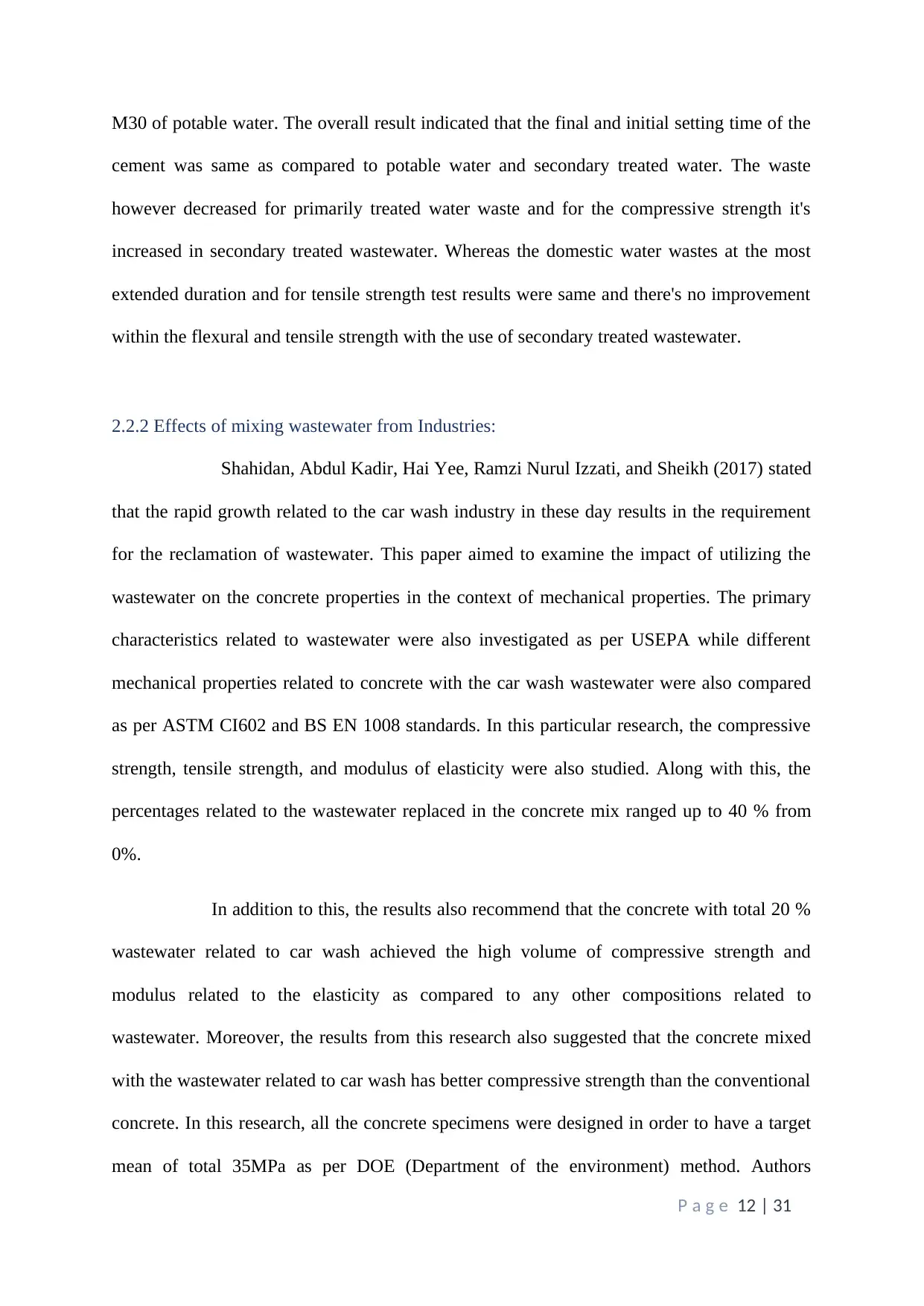
M30 of potable water. The overall result indicated that the final and initial setting time of the
cement was same as compared to potable water and secondary treated water. The waste
however decreased for primarily treated water waste and for the compressive strength it's
increased in secondary treated wastewater. Whereas the domestic water wastes at the most
extended duration and for tensile strength test results were same and there's no improvement
within the flexural and tensile strength with the use of secondary treated wastewater.
2.2.2 Effects of mixing wastewater from Industries:
Shahidan, Abdul Kadir, Hai Yee, Ramzi Nurul Izzati, and Sheikh (2017) stated
that the rapid growth related to the car wash industry in these day results in the requirement
for the reclamation of wastewater. This paper aimed to examine the impact of utilizing the
wastewater on the concrete properties in the context of mechanical properties. The primary
characteristics related to wastewater were also investigated as per USEPA while different
mechanical properties related to concrete with the car wash wastewater were also compared
as per ASTM CI602 and BS EN 1008 standards. In this particular research, the compressive
strength, tensile strength, and modulus of elasticity were also studied. Along with this, the
percentages related to the wastewater replaced in the concrete mix ranged up to 40 % from
0%.
In addition to this, the results also recommend that the concrete with total 20 %
wastewater related to car wash achieved the high volume of compressive strength and
modulus related to the elasticity as compared to any other compositions related to
wastewater. Moreover, the results from this research also suggested that the concrete mixed
with the wastewater related to car wash has better compressive strength than the conventional
concrete. In this research, all the concrete specimens were designed in order to have a target
mean of total 35MPa as per DOE (Department of the environment) method. Authors
P a g e 12 | 31
cement was same as compared to potable water and secondary treated water. The waste
however decreased for primarily treated water waste and for the compressive strength it's
increased in secondary treated wastewater. Whereas the domestic water wastes at the most
extended duration and for tensile strength test results were same and there's no improvement
within the flexural and tensile strength with the use of secondary treated wastewater.
2.2.2 Effects of mixing wastewater from Industries:
Shahidan, Abdul Kadir, Hai Yee, Ramzi Nurul Izzati, and Sheikh (2017) stated
that the rapid growth related to the car wash industry in these day results in the requirement
for the reclamation of wastewater. This paper aimed to examine the impact of utilizing the
wastewater on the concrete properties in the context of mechanical properties. The primary
characteristics related to wastewater were also investigated as per USEPA while different
mechanical properties related to concrete with the car wash wastewater were also compared
as per ASTM CI602 and BS EN 1008 standards. In this particular research, the compressive
strength, tensile strength, and modulus of elasticity were also studied. Along with this, the
percentages related to the wastewater replaced in the concrete mix ranged up to 40 % from
0%.
In addition to this, the results also recommend that the concrete with total 20 %
wastewater related to car wash achieved the high volume of compressive strength and
modulus related to the elasticity as compared to any other compositions related to
wastewater. Moreover, the results from this research also suggested that the concrete mixed
with the wastewater related to car wash has better compressive strength than the conventional
concrete. In this research, all the concrete specimens were designed in order to have a target
mean of total 35MPa as per DOE (Department of the environment) method. Authors
P a g e 12 | 31
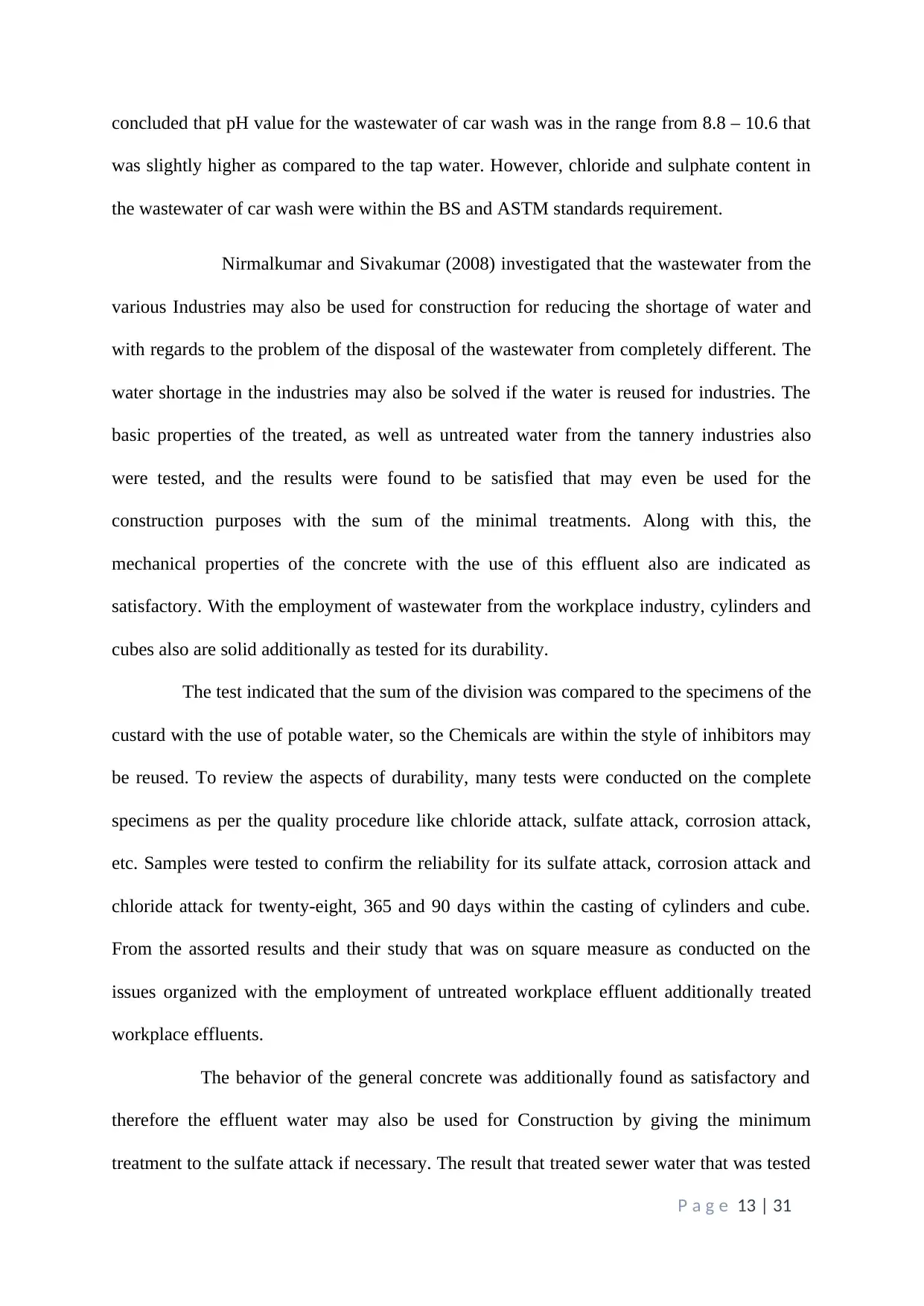
concluded that pH value for the wastewater of car wash was in the range from 8.8 – 10.6 that
was slightly higher as compared to the tap water. However, chloride and sulphate content in
the wastewater of car wash were within the BS and ASTM standards requirement.
Nirmalkumar and Sivakumar (2008) investigated that the wastewater from the
various Industries may also be used for construction for reducing the shortage of water and
with regards to the problem of the disposal of the wastewater from completely different. The
water shortage in the industries may also be solved if the water is reused for industries. The
basic properties of the treated, as well as untreated water from the tannery industries also
were tested, and the results were found to be satisfied that may even be used for the
construction purposes with the sum of the minimal treatments. Along with this, the
mechanical properties of the concrete with the use of this effluent also are indicated as
satisfactory. With the employment of wastewater from the workplace industry, cylinders and
cubes also are solid additionally as tested for its durability.
The test indicated that the sum of the division was compared to the specimens of the
custard with the use of potable water, so the Chemicals are within the style of inhibitors may
be reused. To review the aspects of durability, many tests were conducted on the complete
specimens as per the quality procedure like chloride attack, sulfate attack, corrosion attack,
etc. Samples were tested to confirm the reliability for its sulfate attack, corrosion attack and
chloride attack for twenty-eight, 365 and 90 days within the casting of cylinders and cube.
From the assorted results and their study that was on square measure as conducted on the
issues organized with the employment of untreated workplace effluent additionally treated
workplace effluents.
The behavior of the general concrete was additionally found as satisfactory and
therefore the effluent water may also be used for Construction by giving the minimum
treatment to the sulfate attack if necessary. The result that treated sewer water that was tested
P a g e 13 | 31
was slightly higher as compared to the tap water. However, chloride and sulphate content in
the wastewater of car wash were within the BS and ASTM standards requirement.
Nirmalkumar and Sivakumar (2008) investigated that the wastewater from the
various Industries may also be used for construction for reducing the shortage of water and
with regards to the problem of the disposal of the wastewater from completely different. The
water shortage in the industries may also be solved if the water is reused for industries. The
basic properties of the treated, as well as untreated water from the tannery industries also
were tested, and the results were found to be satisfied that may even be used for the
construction purposes with the sum of the minimal treatments. Along with this, the
mechanical properties of the concrete with the use of this effluent also are indicated as
satisfactory. With the employment of wastewater from the workplace industry, cylinders and
cubes also are solid additionally as tested for its durability.
The test indicated that the sum of the division was compared to the specimens of the
custard with the use of potable water, so the Chemicals are within the style of inhibitors may
be reused. To review the aspects of durability, many tests were conducted on the complete
specimens as per the quality procedure like chloride attack, sulfate attack, corrosion attack,
etc. Samples were tested to confirm the reliability for its sulfate attack, corrosion attack and
chloride attack for twenty-eight, 365 and 90 days within the casting of cylinders and cube.
From the assorted results and their study that was on square measure as conducted on the
issues organized with the employment of untreated workplace effluent additionally treated
workplace effluents.
The behavior of the general concrete was additionally found as satisfactory and
therefore the effluent water may also be used for Construction by giving the minimum
treatment to the sulfate attack if necessary. The result that treated sewer water that was tested
P a g e 13 | 31
Paraphrase This Document
Need a fresh take? Get an instant paraphrase of this document with our AI Paraphraser
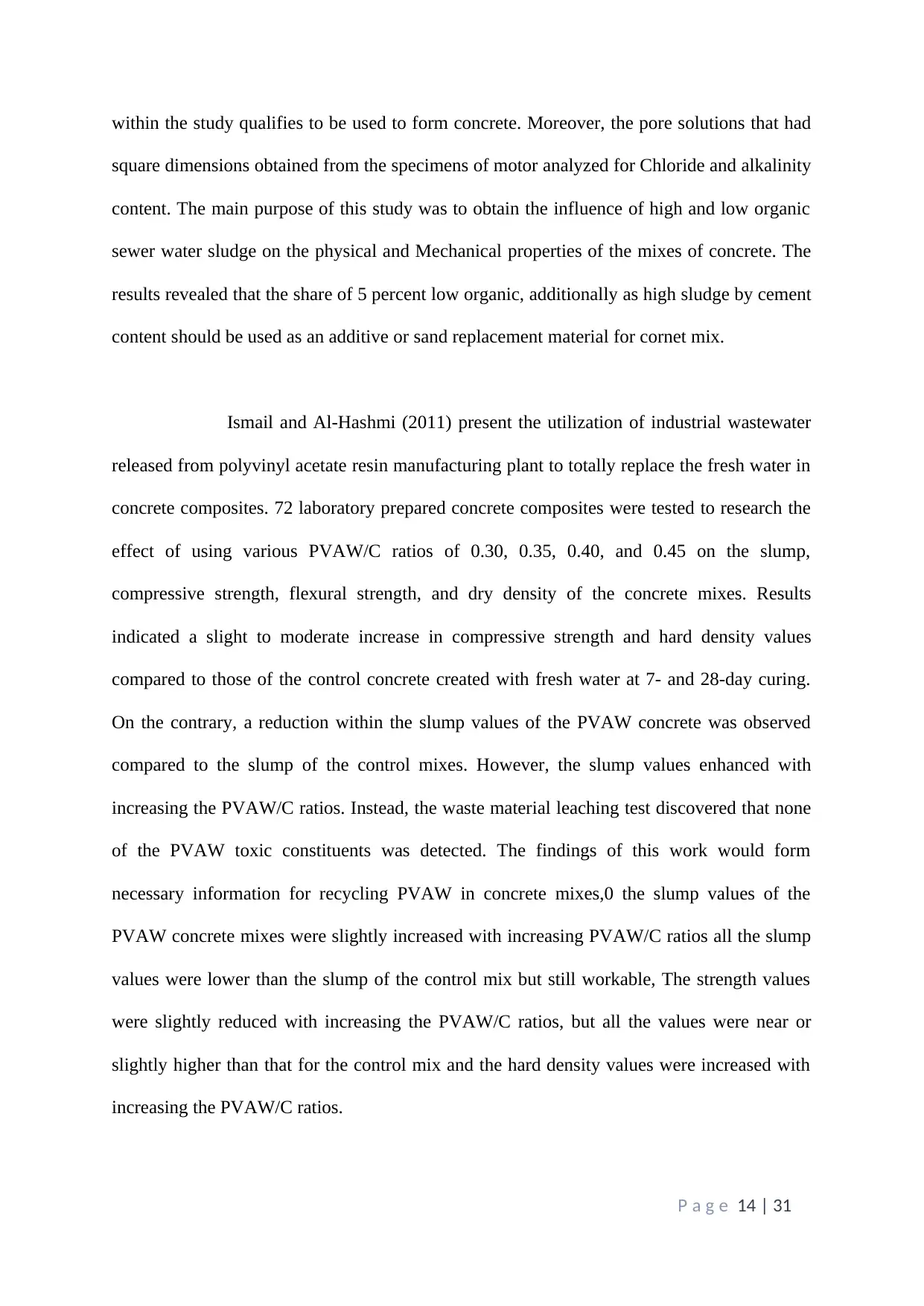
within the study qualifies to be used to form concrete. Moreover, the pore solutions that had
square dimensions obtained from the specimens of motor analyzed for Chloride and alkalinity
content. The main purpose of this study was to obtain the influence of high and low organic
sewer water sludge on the physical and Mechanical properties of the mixes of concrete. The
results revealed that the share of 5 percent low organic, additionally as high sludge by cement
content should be used as an additive or sand replacement material for cornet mix.
Ismail and Al-Hashmi (2011) present the utilization of industrial wastewater
released from polyvinyl acetate resin manufacturing plant to totally replace the fresh water in
concrete composites. 72 laboratory prepared concrete composites were tested to research the
effect of using various PVAW/C ratios of 0.30, 0.35, 0.40, and 0.45 on the slump,
compressive strength, flexural strength, and dry density of the concrete mixes. Results
indicated a slight to moderate increase in compressive strength and hard density values
compared to those of the control concrete created with fresh water at 7- and 28-day curing.
On the contrary, a reduction within the slump values of the PVAW concrete was observed
compared to the slump of the control mixes. However, the slump values enhanced with
increasing the PVAW/C ratios. Instead, the waste material leaching test discovered that none
of the PVAW toxic constituents was detected. The findings of this work would form
necessary information for recycling PVAW in concrete mixes,0 the slump values of the
PVAW concrete mixes were slightly increased with increasing PVAW/C ratios all the slump
values were lower than the slump of the control mix but still workable, The strength values
were slightly reduced with increasing the PVAW/C ratios, but all the values were near or
slightly higher than that for the control mix and the hard density values were increased with
increasing the PVAW/C ratios.
P a g e 14 | 31
square dimensions obtained from the specimens of motor analyzed for Chloride and alkalinity
content. The main purpose of this study was to obtain the influence of high and low organic
sewer water sludge on the physical and Mechanical properties of the mixes of concrete. The
results revealed that the share of 5 percent low organic, additionally as high sludge by cement
content should be used as an additive or sand replacement material for cornet mix.
Ismail and Al-Hashmi (2011) present the utilization of industrial wastewater
released from polyvinyl acetate resin manufacturing plant to totally replace the fresh water in
concrete composites. 72 laboratory prepared concrete composites were tested to research the
effect of using various PVAW/C ratios of 0.30, 0.35, 0.40, and 0.45 on the slump,
compressive strength, flexural strength, and dry density of the concrete mixes. Results
indicated a slight to moderate increase in compressive strength and hard density values
compared to those of the control concrete created with fresh water at 7- and 28-day curing.
On the contrary, a reduction within the slump values of the PVAW concrete was observed
compared to the slump of the control mixes. However, the slump values enhanced with
increasing the PVAW/C ratios. Instead, the waste material leaching test discovered that none
of the PVAW toxic constituents was detected. The findings of this work would form
necessary information for recycling PVAW in concrete mixes,0 the slump values of the
PVAW concrete mixes were slightly increased with increasing PVAW/C ratios all the slump
values were lower than the slump of the control mix but still workable, The strength values
were slightly reduced with increasing the PVAW/C ratios, but all the values were near or
slightly higher than that for the control mix and the hard density values were increased with
increasing the PVAW/C ratios.
P a g e 14 | 31
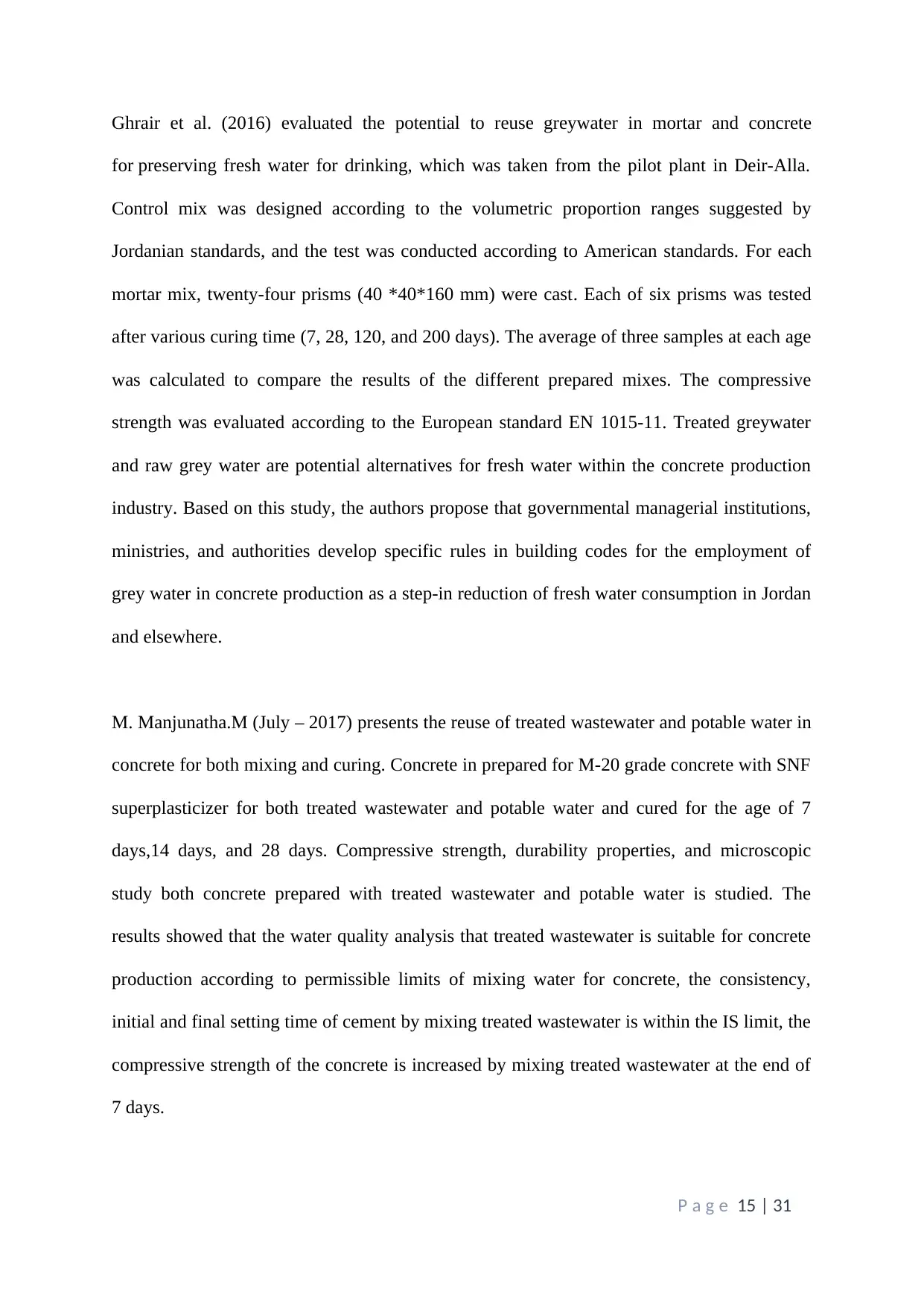
Ghrair et al. (2016) evaluated the potential to reuse greywater in mortar and concrete
for preserving fresh water for drinking, which was taken from the pilot plant in Deir-Alla.
Control mix was designed according to the volumetric proportion ranges suggested by
Jordanian standards, and the test was conducted according to American standards. For each
mortar mix, twenty-four prisms (40 *40*160 mm) were cast. Each of six prisms was tested
after various curing time (7, 28, 120, and 200 days). The average of three samples at each age
was calculated to compare the results of the different prepared mixes. The compressive
strength was evaluated according to the European standard EN 1015-11. Treated greywater
and raw grey water are potential alternatives for fresh water within the concrete production
industry. Based on this study, the authors propose that governmental managerial institutions,
ministries, and authorities develop specific rules in building codes for the employment of
grey water in concrete production as a step-in reduction of fresh water consumption in Jordan
and elsewhere.
M. Manjunatha.M (July – 2017) presents the reuse of treated wastewater and potable water in
concrete for both mixing and curing. Concrete in prepared for M-20 grade concrete with SNF
superplasticizer for both treated wastewater and potable water and cured for the age of 7
days,14 days, and 28 days. Compressive strength, durability properties, and microscopic
study both concrete prepared with treated wastewater and potable water is studied. The
results showed that the water quality analysis that treated wastewater is suitable for concrete
production according to permissible limits of mixing water for concrete, the consistency,
initial and final setting time of cement by mixing treated wastewater is within the IS limit, the
compressive strength of the concrete is increased by mixing treated wastewater at the end of
7 days.
P a g e 15 | 31
for preserving fresh water for drinking, which was taken from the pilot plant in Deir-Alla.
Control mix was designed according to the volumetric proportion ranges suggested by
Jordanian standards, and the test was conducted according to American standards. For each
mortar mix, twenty-four prisms (40 *40*160 mm) were cast. Each of six prisms was tested
after various curing time (7, 28, 120, and 200 days). The average of three samples at each age
was calculated to compare the results of the different prepared mixes. The compressive
strength was evaluated according to the European standard EN 1015-11. Treated greywater
and raw grey water are potential alternatives for fresh water within the concrete production
industry. Based on this study, the authors propose that governmental managerial institutions,
ministries, and authorities develop specific rules in building codes for the employment of
grey water in concrete production as a step-in reduction of fresh water consumption in Jordan
and elsewhere.
M. Manjunatha.M (July – 2017) presents the reuse of treated wastewater and potable water in
concrete for both mixing and curing. Concrete in prepared for M-20 grade concrete with SNF
superplasticizer for both treated wastewater and potable water and cured for the age of 7
days,14 days, and 28 days. Compressive strength, durability properties, and microscopic
study both concrete prepared with treated wastewater and potable water is studied. The
results showed that the water quality analysis that treated wastewater is suitable for concrete
production according to permissible limits of mixing water for concrete, the consistency,
initial and final setting time of cement by mixing treated wastewater is within the IS limit, the
compressive strength of the concrete is increased by mixing treated wastewater at the end of
7 days.
P a g e 15 | 31
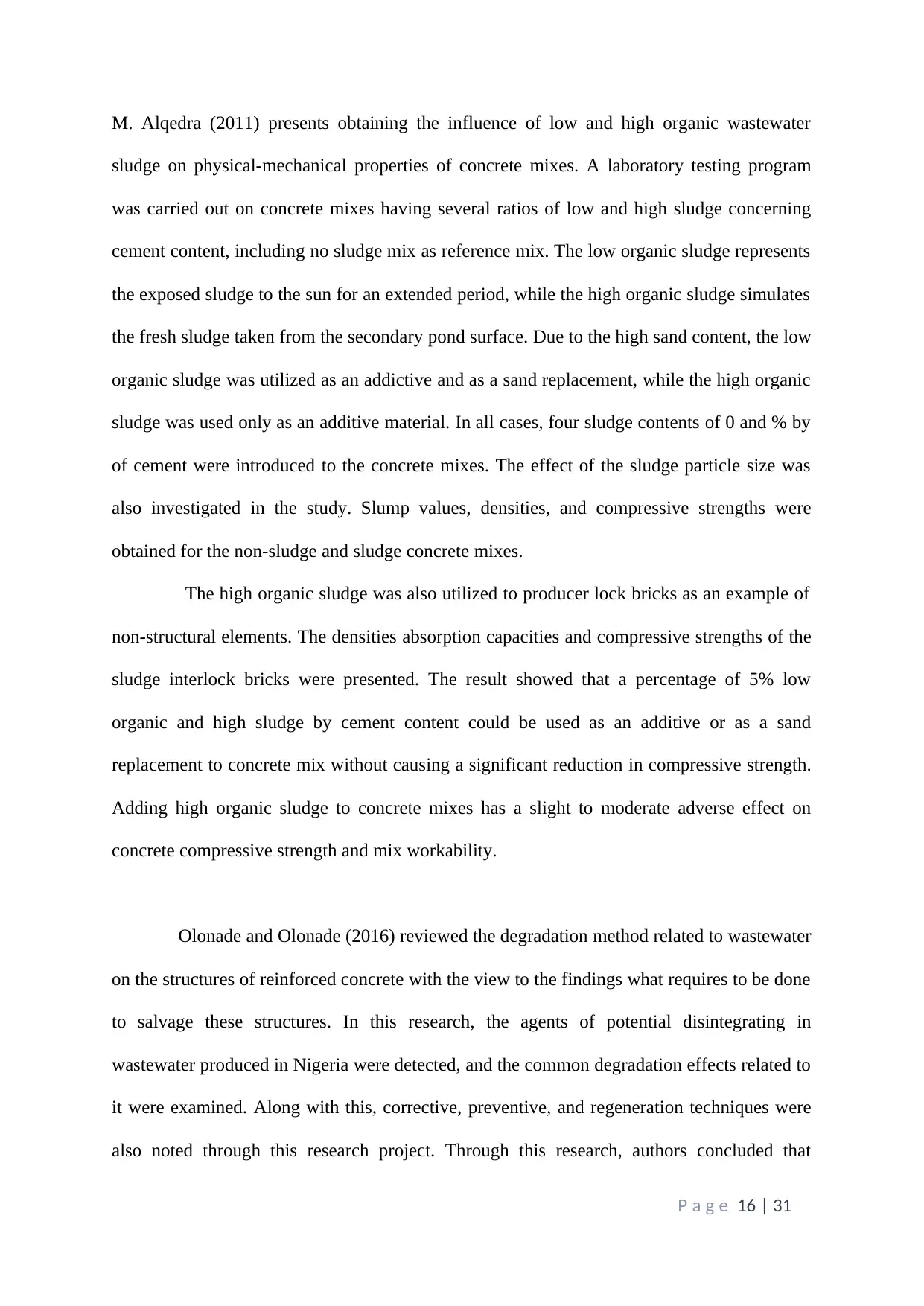
M. Alqedra (2011) presents obtaining the influence of low and high organic wastewater
sludge on physical-mechanical properties of concrete mixes. A laboratory testing program
was carried out on concrete mixes having several ratios of low and high sludge concerning
cement content, including no sludge mix as reference mix. The low organic sludge represents
the exposed sludge to the sun for an extended period, while the high organic sludge simulates
the fresh sludge taken from the secondary pond surface. Due to the high sand content, the low
organic sludge was utilized as an addictive and as a sand replacement, while the high organic
sludge was used only as an additive material. In all cases, four sludge contents of 0 and % by
of cement were introduced to the concrete mixes. The effect of the sludge particle size was
also investigated in the study. Slump values, densities, and compressive strengths were
obtained for the non-sludge and sludge concrete mixes.
The high organic sludge was also utilized to producer lock bricks as an example of
non-structural elements. The densities absorption capacities and compressive strengths of the
sludge interlock bricks were presented. The result showed that a percentage of 5% low
organic and high sludge by cement content could be used as an additive or as a sand
replacement to concrete mix without causing a significant reduction in compressive strength.
Adding high organic sludge to concrete mixes has a slight to moderate adverse effect on
concrete compressive strength and mix workability.
Olonade and Olonade (2016) reviewed the degradation method related to wastewater
on the structures of reinforced concrete with the view to the findings what requires to be done
to salvage these structures. In this research, the agents of potential disintegrating in
wastewater produced in Nigeria were detected, and the common degradation effects related to
it were examined. Along with this, corrective, preventive, and regeneration techniques were
also noted through this research project. Through this research, authors concluded that
P a g e 16 | 31
sludge on physical-mechanical properties of concrete mixes. A laboratory testing program
was carried out on concrete mixes having several ratios of low and high sludge concerning
cement content, including no sludge mix as reference mix. The low organic sludge represents
the exposed sludge to the sun for an extended period, while the high organic sludge simulates
the fresh sludge taken from the secondary pond surface. Due to the high sand content, the low
organic sludge was utilized as an addictive and as a sand replacement, while the high organic
sludge was used only as an additive material. In all cases, four sludge contents of 0 and % by
of cement were introduced to the concrete mixes. The effect of the sludge particle size was
also investigated in the study. Slump values, densities, and compressive strengths were
obtained for the non-sludge and sludge concrete mixes.
The high organic sludge was also utilized to producer lock bricks as an example of
non-structural elements. The densities absorption capacities and compressive strengths of the
sludge interlock bricks were presented. The result showed that a percentage of 5% low
organic and high sludge by cement content could be used as an additive or as a sand
replacement to concrete mix without causing a significant reduction in compressive strength.
Adding high organic sludge to concrete mixes has a slight to moderate adverse effect on
concrete compressive strength and mix workability.
Olonade and Olonade (2016) reviewed the degradation method related to wastewater
on the structures of reinforced concrete with the view to the findings what requires to be done
to salvage these structures. In this research, the agents of potential disintegrating in
wastewater produced in Nigeria were detected, and the common degradation effects related to
it were examined. Along with this, corrective, preventive, and regeneration techniques were
also noted through this research project. Through this research, authors concluded that
P a g e 16 | 31
Secure Best Marks with AI Grader
Need help grading? Try our AI Grader for instant feedback on your assignments.
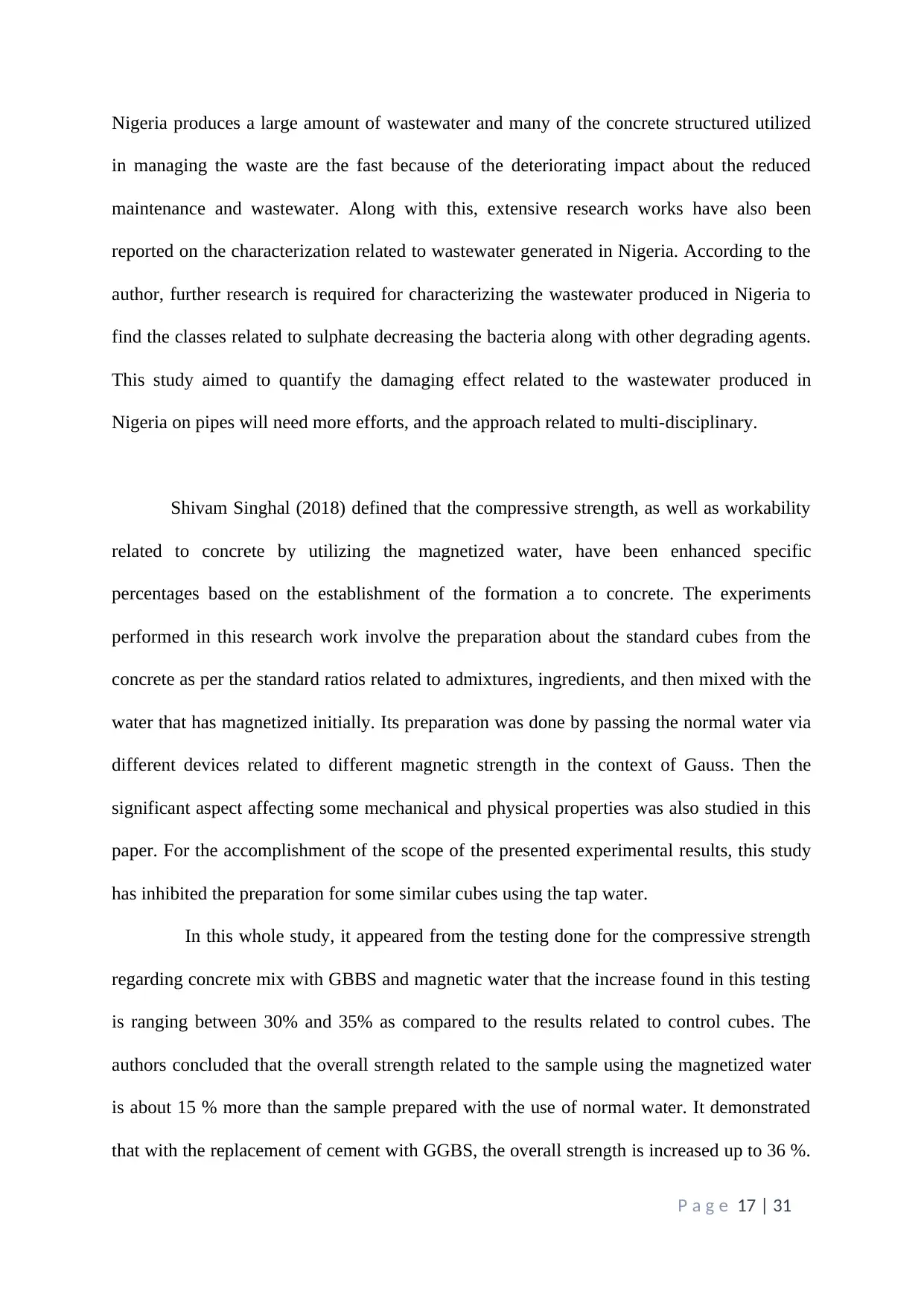
Nigeria produces a large amount of wastewater and many of the concrete structured utilized
in managing the waste are the fast because of the deteriorating impact about the reduced
maintenance and wastewater. Along with this, extensive research works have also been
reported on the characterization related to wastewater generated in Nigeria. According to the
author, further research is required for characterizing the wastewater produced in Nigeria to
find the classes related to sulphate decreasing the bacteria along with other degrading agents.
This study aimed to quantify the damaging effect related to the wastewater produced in
Nigeria on pipes will need more efforts, and the approach related to multi-disciplinary.
Shivam Singhal (2018) defined that the compressive strength, as well as workability
related to concrete by utilizing the magnetized water, have been enhanced specific
percentages based on the establishment of the formation a to concrete. The experiments
performed in this research work involve the preparation about the standard cubes from the
concrete as per the standard ratios related to admixtures, ingredients, and then mixed with the
water that has magnetized initially. Its preparation was done by passing the normal water via
different devices related to different magnetic strength in the context of Gauss. Then the
significant aspect affecting some mechanical and physical properties was also studied in this
paper. For the accomplishment of the scope of the presented experimental results, this study
has inhibited the preparation for some similar cubes using the tap water.
In this whole study, it appeared from the testing done for the compressive strength
regarding concrete mix with GBBS and magnetic water that the increase found in this testing
is ranging between 30% and 35% as compared to the results related to control cubes. The
authors concluded that the overall strength related to the sample using the magnetized water
is about 15 % more than the sample prepared with the use of normal water. It demonstrated
that with the replacement of cement with GGBS, the overall strength is increased up to 36 %.
P a g e 17 | 31
in managing the waste are the fast because of the deteriorating impact about the reduced
maintenance and wastewater. Along with this, extensive research works have also been
reported on the characterization related to wastewater generated in Nigeria. According to the
author, further research is required for characterizing the wastewater produced in Nigeria to
find the classes related to sulphate decreasing the bacteria along with other degrading agents.
This study aimed to quantify the damaging effect related to the wastewater produced in
Nigeria on pipes will need more efforts, and the approach related to multi-disciplinary.
Shivam Singhal (2018) defined that the compressive strength, as well as workability
related to concrete by utilizing the magnetized water, have been enhanced specific
percentages based on the establishment of the formation a to concrete. The experiments
performed in this research work involve the preparation about the standard cubes from the
concrete as per the standard ratios related to admixtures, ingredients, and then mixed with the
water that has magnetized initially. Its preparation was done by passing the normal water via
different devices related to different magnetic strength in the context of Gauss. Then the
significant aspect affecting some mechanical and physical properties was also studied in this
paper. For the accomplishment of the scope of the presented experimental results, this study
has inhibited the preparation for some similar cubes using the tap water.
In this whole study, it appeared from the testing done for the compressive strength
regarding concrete mix with GBBS and magnetic water that the increase found in this testing
is ranging between 30% and 35% as compared to the results related to control cubes. The
authors concluded that the overall strength related to the sample using the magnetized water
is about 15 % more than the sample prepared with the use of normal water. It demonstrated
that with the replacement of cement with GGBS, the overall strength is increased up to 36 %.
P a g e 17 | 31
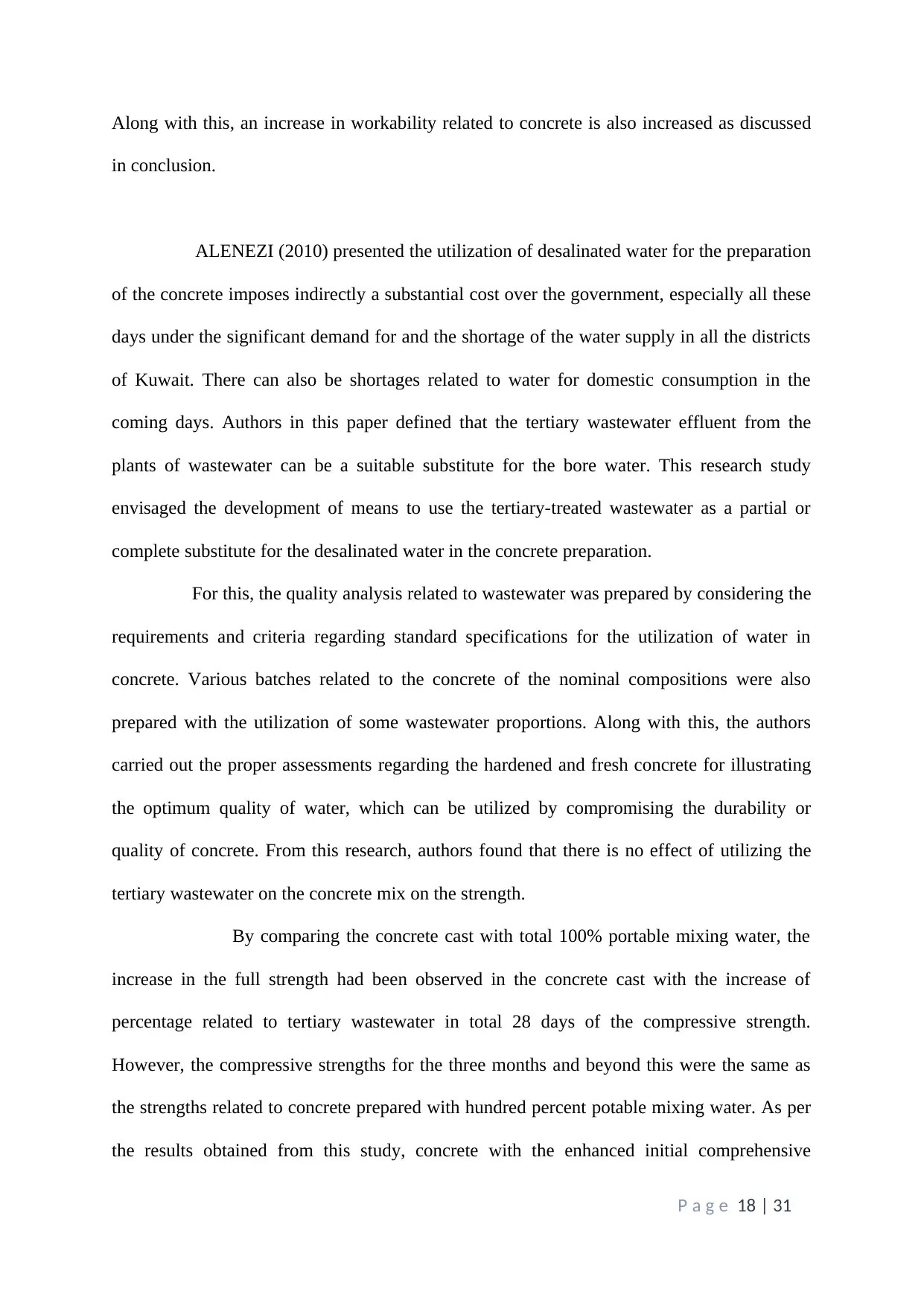
Along with this, an increase in workability related to concrete is also increased as discussed
in conclusion.
ALENEZI (2010) presented the utilization of desalinated water for the preparation
of the concrete imposes indirectly a substantial cost over the government, especially all these
days under the significant demand for and the shortage of the water supply in all the districts
of Kuwait. There can also be shortages related to water for domestic consumption in the
coming days. Authors in this paper defined that the tertiary wastewater effluent from the
plants of wastewater can be a suitable substitute for the bore water. This research study
envisaged the development of means to use the tertiary-treated wastewater as a partial or
complete substitute for the desalinated water in the concrete preparation.
For this, the quality analysis related to wastewater was prepared by considering the
requirements and criteria regarding standard specifications for the utilization of water in
concrete. Various batches related to the concrete of the nominal compositions were also
prepared with the utilization of some wastewater proportions. Along with this, the authors
carried out the proper assessments regarding the hardened and fresh concrete for illustrating
the optimum quality of water, which can be utilized by compromising the durability or
quality of concrete. From this research, authors found that there is no effect of utilizing the
tertiary wastewater on the concrete mix on the strength.
By comparing the concrete cast with total 100% portable mixing water, the
increase in the full strength had been observed in the concrete cast with the increase of
percentage related to tertiary wastewater in total 28 days of the compressive strength.
However, the compressive strengths for the three months and beyond this were the same as
the strengths related to concrete prepared with hundred percent potable mixing water. As per
the results obtained from this study, concrete with the enhanced initial comprehensive
P a g e 18 | 31
in conclusion.
ALENEZI (2010) presented the utilization of desalinated water for the preparation
of the concrete imposes indirectly a substantial cost over the government, especially all these
days under the significant demand for and the shortage of the water supply in all the districts
of Kuwait. There can also be shortages related to water for domestic consumption in the
coming days. Authors in this paper defined that the tertiary wastewater effluent from the
plants of wastewater can be a suitable substitute for the bore water. This research study
envisaged the development of means to use the tertiary-treated wastewater as a partial or
complete substitute for the desalinated water in the concrete preparation.
For this, the quality analysis related to wastewater was prepared by considering the
requirements and criteria regarding standard specifications for the utilization of water in
concrete. Various batches related to the concrete of the nominal compositions were also
prepared with the utilization of some wastewater proportions. Along with this, the authors
carried out the proper assessments regarding the hardened and fresh concrete for illustrating
the optimum quality of water, which can be utilized by compromising the durability or
quality of concrete. From this research, authors found that there is no effect of utilizing the
tertiary wastewater on the concrete mix on the strength.
By comparing the concrete cast with total 100% portable mixing water, the
increase in the full strength had been observed in the concrete cast with the increase of
percentage related to tertiary wastewater in total 28 days of the compressive strength.
However, the compressive strengths for the three months and beyond this were the same as
the strengths related to concrete prepared with hundred percent potable mixing water. As per
the results obtained from this study, concrete with the enhanced initial comprehensive
P a g e 18 | 31
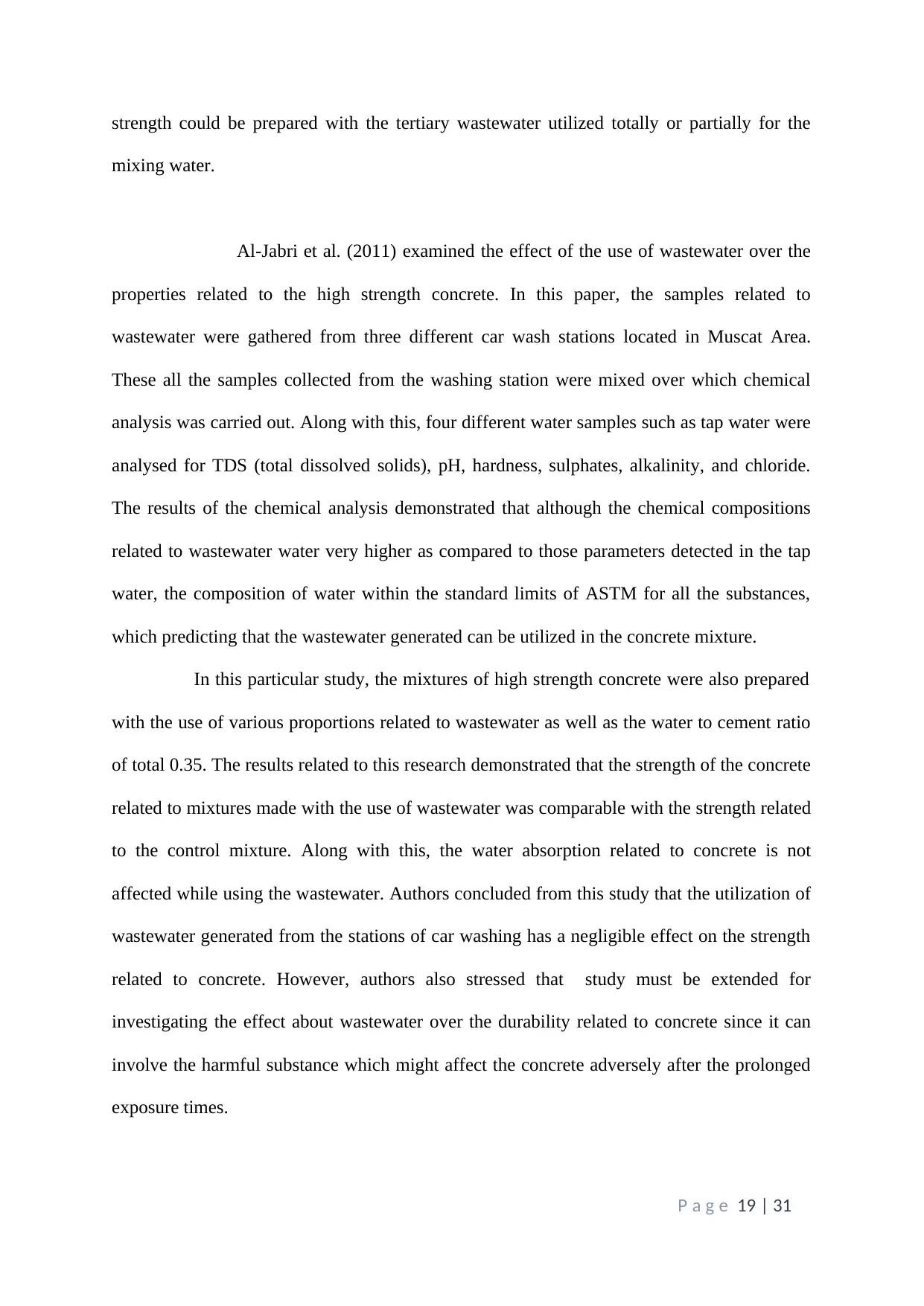
strength could be prepared with the tertiary wastewater utilized totally or partially for the
mixing water.
Al-Jabri et al. (2011) examined the effect of the use of wastewater over the
properties related to the high strength concrete. In this paper, the samples related to
wastewater were gathered from three different car wash stations located in Muscat Area.
These all the samples collected from the washing station were mixed over which chemical
analysis was carried out. Along with this, four different water samples such as tap water were
analysed for TDS (total dissolved solids), pH, hardness, sulphates, alkalinity, and chloride.
The results of the chemical analysis demonstrated that although the chemical compositions
related to wastewater water very higher as compared to those parameters detected in the tap
water, the composition of water within the standard limits of ASTM for all the substances,
which predicting that the wastewater generated can be utilized in the concrete mixture.
In this particular study, the mixtures of high strength concrete were also prepared
with the use of various proportions related to wastewater as well as the water to cement ratio
of total 0.35. The results related to this research demonstrated that the strength of the concrete
related to mixtures made with the use of wastewater was comparable with the strength related
to the control mixture. Along with this, the water absorption related to concrete is not
affected while using the wastewater. Authors concluded from this study that the utilization of
wastewater generated from the stations of car washing has a negligible effect on the strength
related to concrete. However, authors also stressed that study must be extended for
investigating the effect about wastewater over the durability related to concrete since it can
involve the harmful substance which might affect the concrete adversely after the prolonged
exposure times.
P a g e 19 | 31
mixing water.
Al-Jabri et al. (2011) examined the effect of the use of wastewater over the
properties related to the high strength concrete. In this paper, the samples related to
wastewater were gathered from three different car wash stations located in Muscat Area.
These all the samples collected from the washing station were mixed over which chemical
analysis was carried out. Along with this, four different water samples such as tap water were
analysed for TDS (total dissolved solids), pH, hardness, sulphates, alkalinity, and chloride.
The results of the chemical analysis demonstrated that although the chemical compositions
related to wastewater water very higher as compared to those parameters detected in the tap
water, the composition of water within the standard limits of ASTM for all the substances,
which predicting that the wastewater generated can be utilized in the concrete mixture.
In this particular study, the mixtures of high strength concrete were also prepared
with the use of various proportions related to wastewater as well as the water to cement ratio
of total 0.35. The results related to this research demonstrated that the strength of the concrete
related to mixtures made with the use of wastewater was comparable with the strength related
to the control mixture. Along with this, the water absorption related to concrete is not
affected while using the wastewater. Authors concluded from this study that the utilization of
wastewater generated from the stations of car washing has a negligible effect on the strength
related to concrete. However, authors also stressed that study must be extended for
investigating the effect about wastewater over the durability related to concrete since it can
involve the harmful substance which might affect the concrete adversely after the prolonged
exposure times.
P a g e 19 | 31
Paraphrase This Document
Need a fresh take? Get an instant paraphrase of this document with our AI Paraphraser
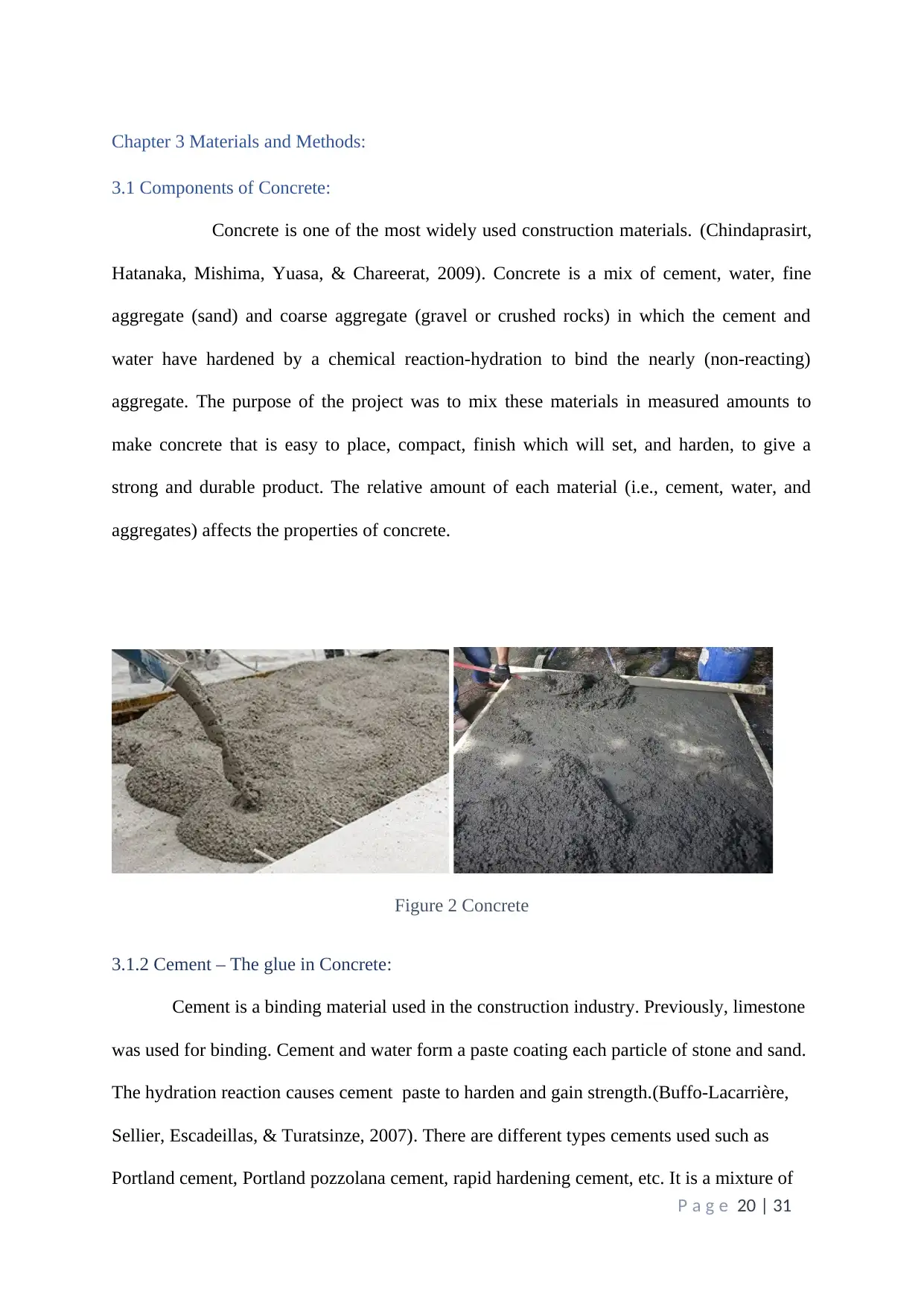
Chapter 3 Materials and Methods:
3.1 Components of Concrete:
Concrete is one of the most widely used construction materials. (Chindaprasirt,
Hatanaka, Mishima, Yuasa, & Chareerat, 2009). Concrete is a mix of cement, water, fine
aggregate (sand) and coarse aggregate (gravel or crushed rocks) in which the cement and
water have hardened by a chemical reaction-hydration to bind the nearly (non-reacting)
aggregate. The purpose of the project was to mix these materials in measured amounts to
make concrete that is easy to place, compact, finish which will set, and harden, to give a
strong and durable product. The relative amount of each material (i.e., cement, water, and
aggregates) affects the properties of concrete.
Figure 2 Concrete
3.1.2 Cement – The glue in Concrete:
Cement is a binding material used in the construction industry. Previously, limestone
was used for binding. Cement and water form a paste coating each particle of stone and sand.
The hydration reaction causes cement paste to harden and gain strength.(Buffo-Lacarrière,
Sellier, Escadeillas, & Turatsinze, 2007). There are different types cements used such as
Portland cement, Portland pozzolana cement, rapid hardening cement, etc. It is a mixture of
P a g e 20 | 31
3.1 Components of Concrete:
Concrete is one of the most widely used construction materials. (Chindaprasirt,
Hatanaka, Mishima, Yuasa, & Chareerat, 2009). Concrete is a mix of cement, water, fine
aggregate (sand) and coarse aggregate (gravel or crushed rocks) in which the cement and
water have hardened by a chemical reaction-hydration to bind the nearly (non-reacting)
aggregate. The purpose of the project was to mix these materials in measured amounts to
make concrete that is easy to place, compact, finish which will set, and harden, to give a
strong and durable product. The relative amount of each material (i.e., cement, water, and
aggregates) affects the properties of concrete.
Figure 2 Concrete
3.1.2 Cement – The glue in Concrete:
Cement is a binding material used in the construction industry. Previously, limestone
was used for binding. Cement and water form a paste coating each particle of stone and sand.
The hydration reaction causes cement paste to harden and gain strength.(Buffo-Lacarrière,
Sellier, Escadeillas, & Turatsinze, 2007). There are different types cements used such as
Portland cement, Portland pozzolana cement, rapid hardening cement, etc. It is a mixture of
P a g e 20 | 31
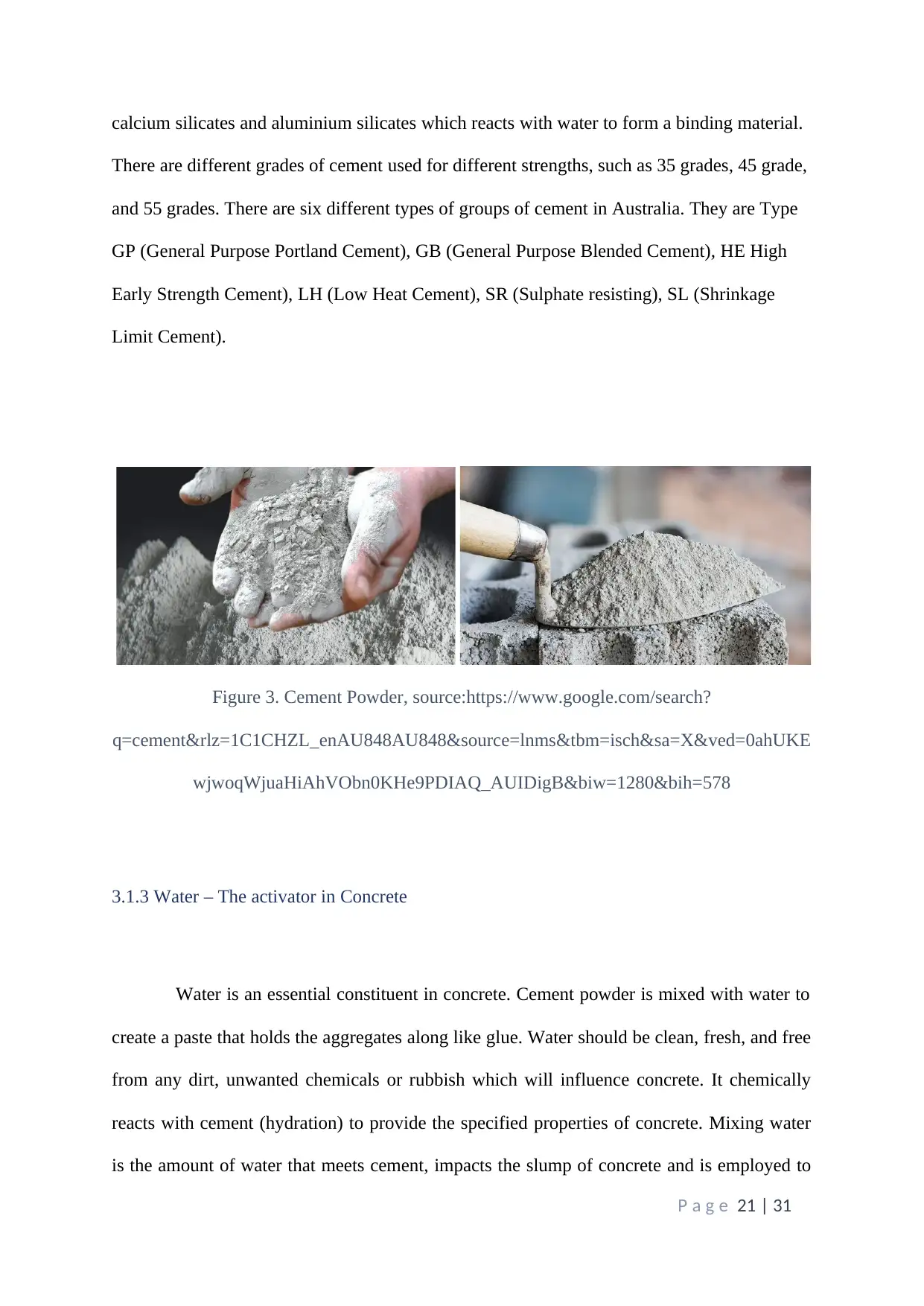
calcium silicates and aluminium silicates which reacts with water to form a binding material.
There are different grades of cement used for different strengths, such as 35 grades, 45 grade,
and 55 grades. There are six different types of groups of cement in Australia. They are Type
GP (General Purpose Portland Cement), GB (General Purpose Blended Cement), HE High
Early Strength Cement), LH (Low Heat Cement), SR (Sulphate resisting), SL (Shrinkage
Limit Cement).
Figure 3. Cement Powder, source:https://www.google.com/search?
q=cement&rlz=1C1CHZL_enAU848AU848&source=lnms&tbm=isch&sa=X&ved=0ahUKE
wjwoqWjuaHiAhVObn0KHe9PDIAQ_AUIDigB&biw=1280&bih=578
3.1.3 Water – The activator in Concrete
Water is an essential constituent in concrete. Cement powder is mixed with water to
create a paste that holds the aggregates along like glue. Water should be clean, fresh, and free
from any dirt, unwanted chemicals or rubbish which will influence concrete. It chemically
reacts with cement (hydration) to provide the specified properties of concrete. Mixing water
is the amount of water that meets cement, impacts the slump of concrete and is employed to
P a g e 21 | 31
There are different grades of cement used for different strengths, such as 35 grades, 45 grade,
and 55 grades. There are six different types of groups of cement in Australia. They are Type
GP (General Purpose Portland Cement), GB (General Purpose Blended Cement), HE High
Early Strength Cement), LH (Low Heat Cement), SR (Sulphate resisting), SL (Shrinkage
Limit Cement).
Figure 3. Cement Powder, source:https://www.google.com/search?
q=cement&rlz=1C1CHZL_enAU848AU848&source=lnms&tbm=isch&sa=X&ved=0ahUKE
wjwoqWjuaHiAhVObn0KHe9PDIAQ_AUIDigB&biw=1280&bih=578
3.1.3 Water – The activator in Concrete
Water is an essential constituent in concrete. Cement powder is mixed with water to
create a paste that holds the aggregates along like glue. Water should be clean, fresh, and free
from any dirt, unwanted chemicals or rubbish which will influence concrete. It chemically
reacts with cement (hydration) to provide the specified properties of concrete. Mixing water
is the amount of water that meets cement, impacts the slump of concrete and is employed to
P a g e 21 | 31
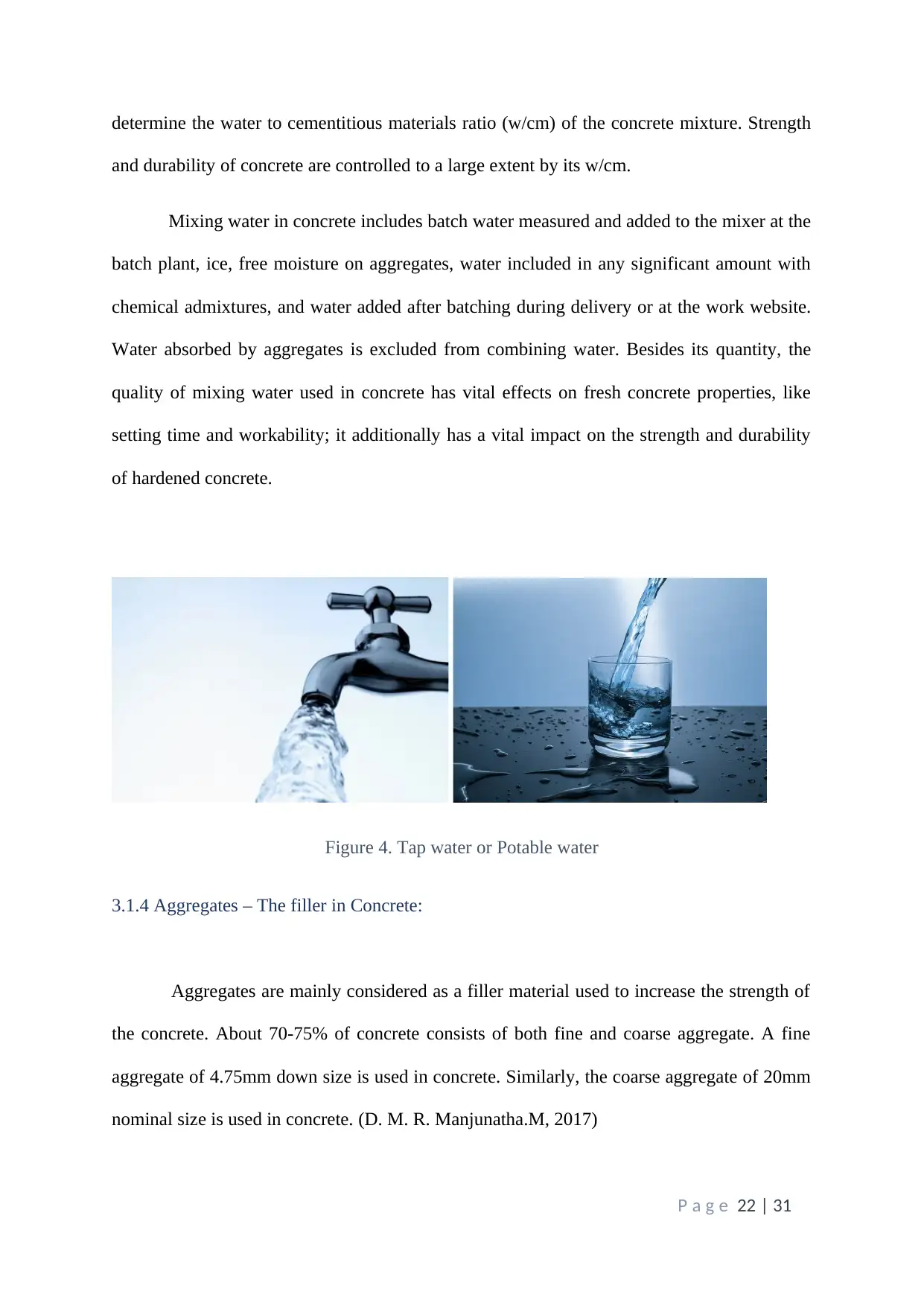
determine the water to cementitious materials ratio (w/cm) of the concrete mixture. Strength
and durability of concrete are controlled to a large extent by its w/cm.
Mixing water in concrete includes batch water measured and added to the mixer at the
batch plant, ice, free moisture on aggregates, water included in any significant amount with
chemical admixtures, and water added after batching during delivery or at the work website.
Water absorbed by aggregates is excluded from combining water. Besides its quantity, the
quality of mixing water used in concrete has vital effects on fresh concrete properties, like
setting time and workability; it additionally has a vital impact on the strength and durability
of hardened concrete.
Figure 4. Tap water or Potable water
3.1.4 Aggregates – The filler in Concrete:
Aggregates are mainly considered as a filler material used to increase the strength of
the concrete. About 70-75% of concrete consists of both fine and coarse aggregate. A fine
aggregate of 4.75mm down size is used in concrete. Similarly, the coarse aggregate of 20mm
nominal size is used in concrete. (D. M. R. Manjunatha.M, 2017)
P a g e 22 | 31
and durability of concrete are controlled to a large extent by its w/cm.
Mixing water in concrete includes batch water measured and added to the mixer at the
batch plant, ice, free moisture on aggregates, water included in any significant amount with
chemical admixtures, and water added after batching during delivery or at the work website.
Water absorbed by aggregates is excluded from combining water. Besides its quantity, the
quality of mixing water used in concrete has vital effects on fresh concrete properties, like
setting time and workability; it additionally has a vital impact on the strength and durability
of hardened concrete.
Figure 4. Tap water or Potable water
3.1.4 Aggregates – The filler in Concrete:
Aggregates are mainly considered as a filler material used to increase the strength of
the concrete. About 70-75% of concrete consists of both fine and coarse aggregate. A fine
aggregate of 4.75mm down size is used in concrete. Similarly, the coarse aggregate of 20mm
nominal size is used in concrete. (D. M. R. Manjunatha.M, 2017)
P a g e 22 | 31
Secure Best Marks with AI Grader
Need help grading? Try our AI Grader for instant feedback on your assignments.
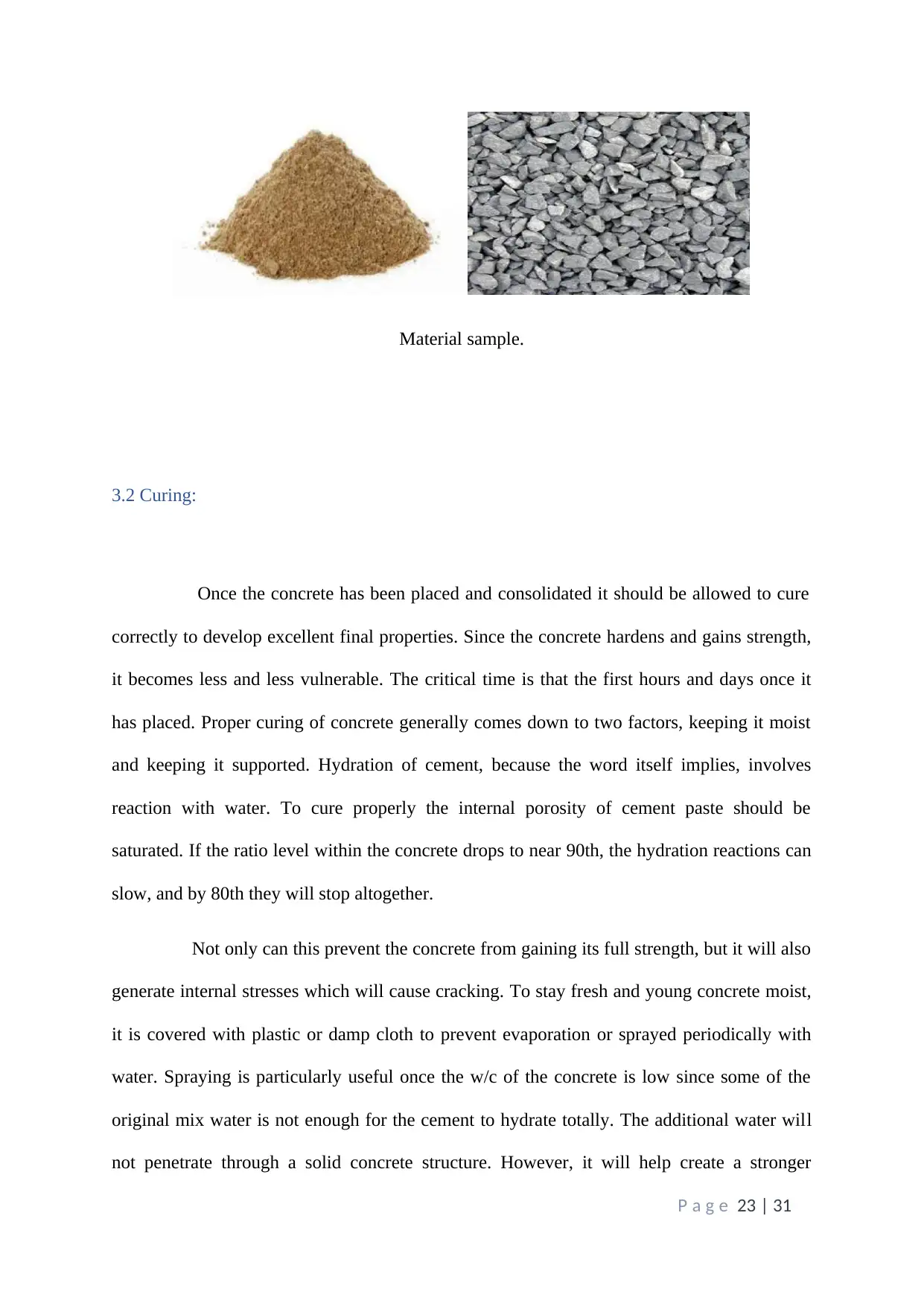
Material sample.
3.2 Curing:
Once the concrete has been placed and consolidated it should be allowed to cure
correctly to develop excellent final properties. Since the concrete hardens and gains strength,
it becomes less and less vulnerable. The critical time is that the first hours and days once it
has placed. Proper curing of concrete generally comes down to two factors, keeping it moist
and keeping it supported. Hydration of cement, because the word itself implies, involves
reaction with water. To cure properly the internal porosity of cement paste should be
saturated. If the ratio level within the concrete drops to near 90th, the hydration reactions can
slow, and by 80th they will stop altogether.
Not only can this prevent the concrete from gaining its full strength, but it will also
generate internal stresses which will cause cracking. To stay fresh and young concrete moist,
it is covered with plastic or damp cloth to prevent evaporation or sprayed periodically with
water. Spraying is particularly useful once the w/c of the concrete is low since some of the
original mix water is not enough for the cement to hydrate totally. The additional water will
not penetrate through a solid concrete structure. However, it will help create a stronger
P a g e 23 | 31
3.2 Curing:
Once the concrete has been placed and consolidated it should be allowed to cure
correctly to develop excellent final properties. Since the concrete hardens and gains strength,
it becomes less and less vulnerable. The critical time is that the first hours and days once it
has placed. Proper curing of concrete generally comes down to two factors, keeping it moist
and keeping it supported. Hydration of cement, because the word itself implies, involves
reaction with water. To cure properly the internal porosity of cement paste should be
saturated. If the ratio level within the concrete drops to near 90th, the hydration reactions can
slow, and by 80th they will stop altogether.
Not only can this prevent the concrete from gaining its full strength, but it will also
generate internal stresses which will cause cracking. To stay fresh and young concrete moist,
it is covered with plastic or damp cloth to prevent evaporation or sprayed periodically with
water. Spraying is particularly useful once the w/c of the concrete is low since some of the
original mix water is not enough for the cement to hydrate totally. The additional water will
not penetrate through a solid concrete structure. However, it will help create a stronger
P a g e 23 | 31
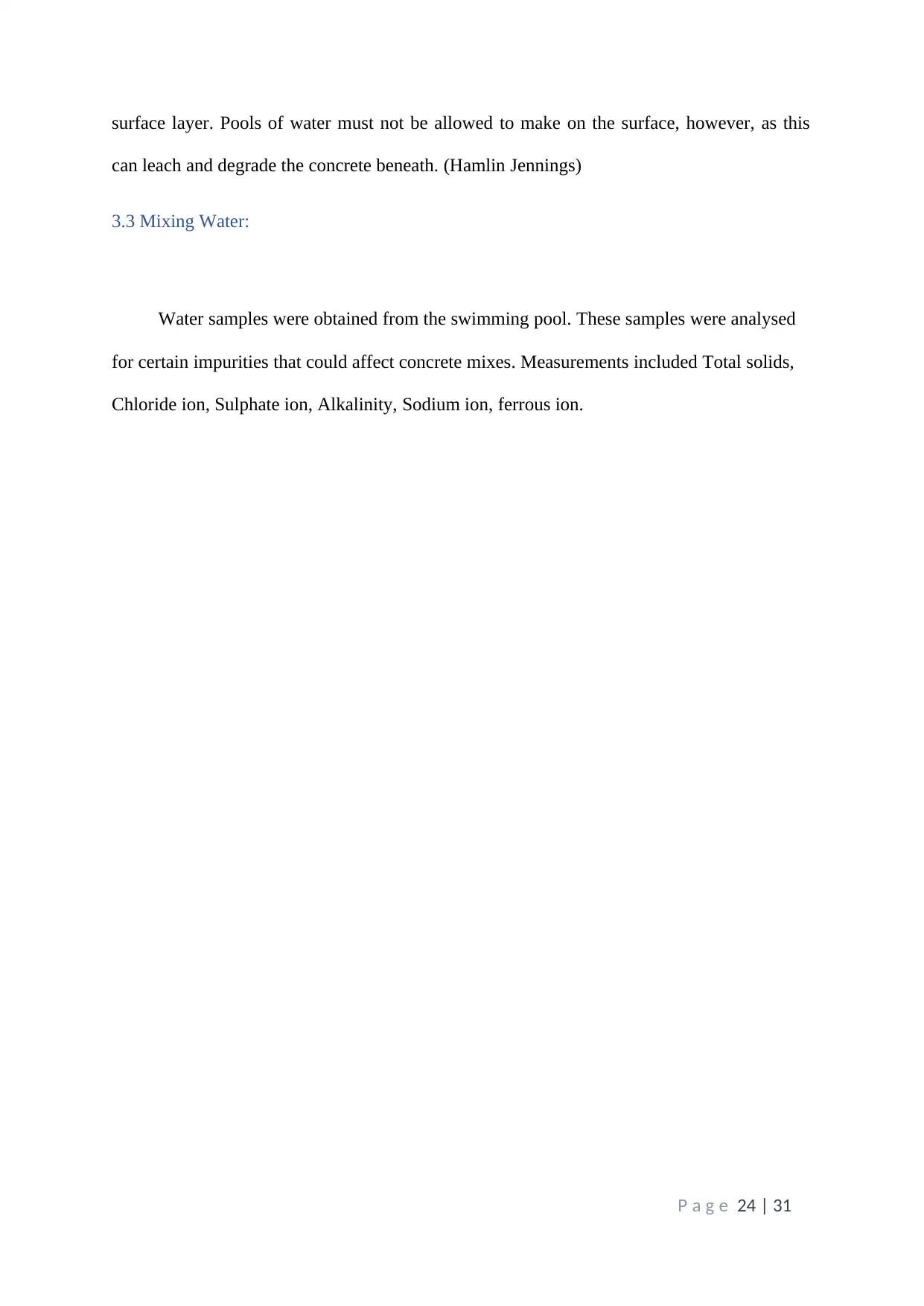
surface layer. Pools of water must not be allowed to make on the surface, however, as this
can leach and degrade the concrete beneath. (Hamlin Jennings)
3.3 Mixing Water:
Water samples were obtained from the swimming pool. These samples were analysed
for certain impurities that could affect concrete mixes. Measurements included Total solids,
Chloride ion, Sulphate ion, Alkalinity, Sodium ion, ferrous ion.
P a g e 24 | 31
can leach and degrade the concrete beneath. (Hamlin Jennings)
3.3 Mixing Water:
Water samples were obtained from the swimming pool. These samples were analysed
for certain impurities that could affect concrete mixes. Measurements included Total solids,
Chloride ion, Sulphate ion, Alkalinity, Sodium ion, ferrous ion.
P a g e 24 | 31
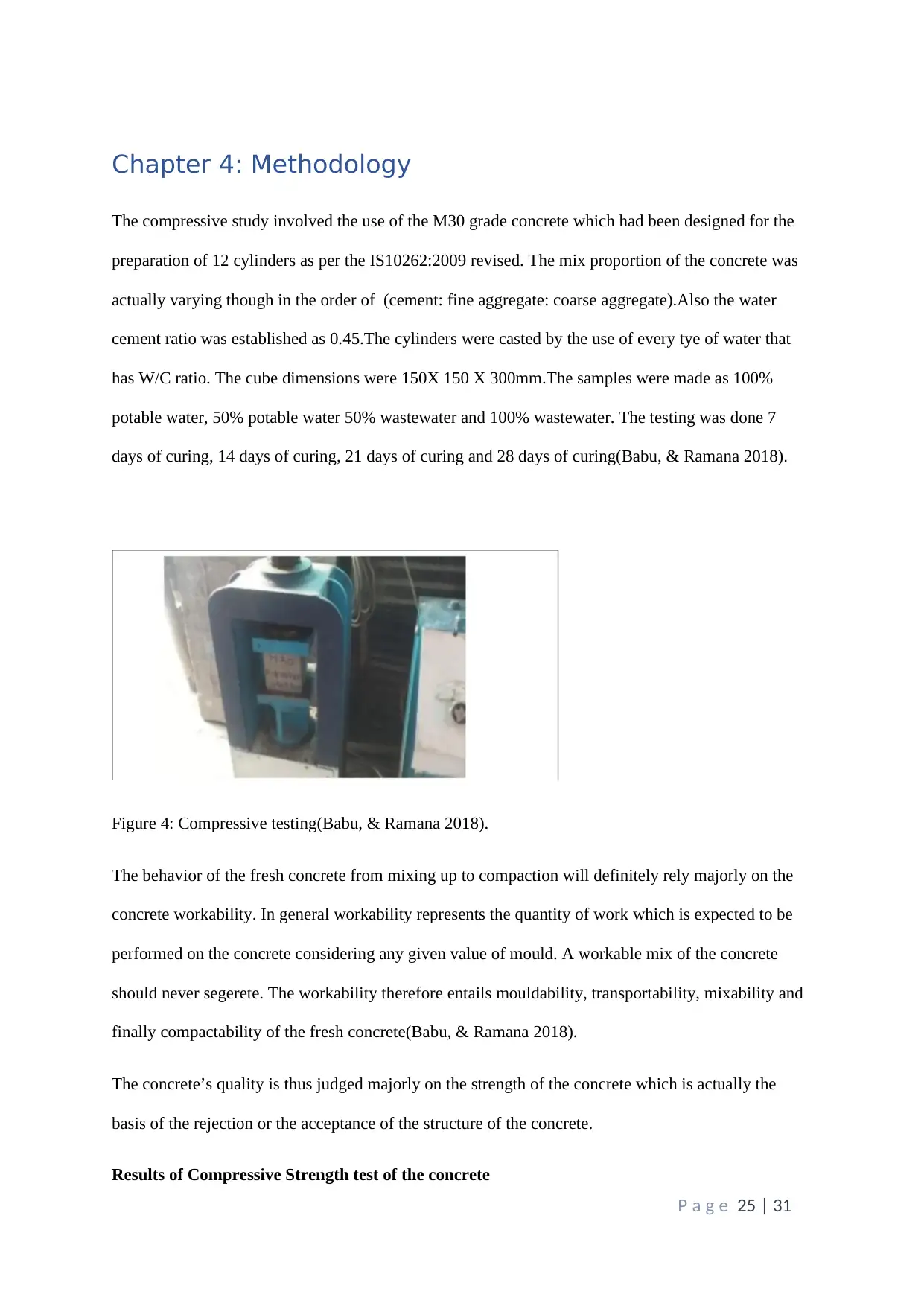
Chapter 4: Methodology
The compressive study involved the use of the M30 grade concrete which had been designed for the
preparation of 12 cylinders as per the IS10262:2009 revised. The mix proportion of the concrete was
actually varying though in the order of (cement: fine aggregate: coarse aggregate).Also the water
cement ratio was established as 0.45.The cylinders were casted by the use of every tye of water that
has W/C ratio. The cube dimensions were 150X 150 X 300mm.The samples were made as 100%
potable water, 50% potable water 50% wastewater and 100% wastewater. The testing was done 7
days of curing, 14 days of curing, 21 days of curing and 28 days of curing(Babu, & Ramana 2018).
Figure 4: Compressive testing(Babu, & Ramana 2018).
The behavior of the fresh concrete from mixing up to compaction will definitely rely majorly on the
concrete workability. In general workability represents the quantity of work which is expected to be
performed on the concrete considering any given value of mould. A workable mix of the concrete
should never segerete. The workability therefore entails mouldability, transportability, mixability and
finally compactability of the fresh concrete(Babu, & Ramana 2018).
The concrete’s quality is thus judged majorly on the strength of the concrete which is actually the
basis of the rejection or the acceptance of the structure of the concrete.
Results of Compressive Strength test of the concrete
P a g e 25 | 31
The compressive study involved the use of the M30 grade concrete which had been designed for the
preparation of 12 cylinders as per the IS10262:2009 revised. The mix proportion of the concrete was
actually varying though in the order of (cement: fine aggregate: coarse aggregate).Also the water
cement ratio was established as 0.45.The cylinders were casted by the use of every tye of water that
has W/C ratio. The cube dimensions were 150X 150 X 300mm.The samples were made as 100%
potable water, 50% potable water 50% wastewater and 100% wastewater. The testing was done 7
days of curing, 14 days of curing, 21 days of curing and 28 days of curing(Babu, & Ramana 2018).
Figure 4: Compressive testing(Babu, & Ramana 2018).
The behavior of the fresh concrete from mixing up to compaction will definitely rely majorly on the
concrete workability. In general workability represents the quantity of work which is expected to be
performed on the concrete considering any given value of mould. A workable mix of the concrete
should never segerete. The workability therefore entails mouldability, transportability, mixability and
finally compactability of the fresh concrete(Babu, & Ramana 2018).
The concrete’s quality is thus judged majorly on the strength of the concrete which is actually the
basis of the rejection or the acceptance of the structure of the concrete.
Results of Compressive Strength test of the concrete
P a g e 25 | 31
Paraphrase This Document
Need a fresh take? Get an instant paraphrase of this document with our AI Paraphraser
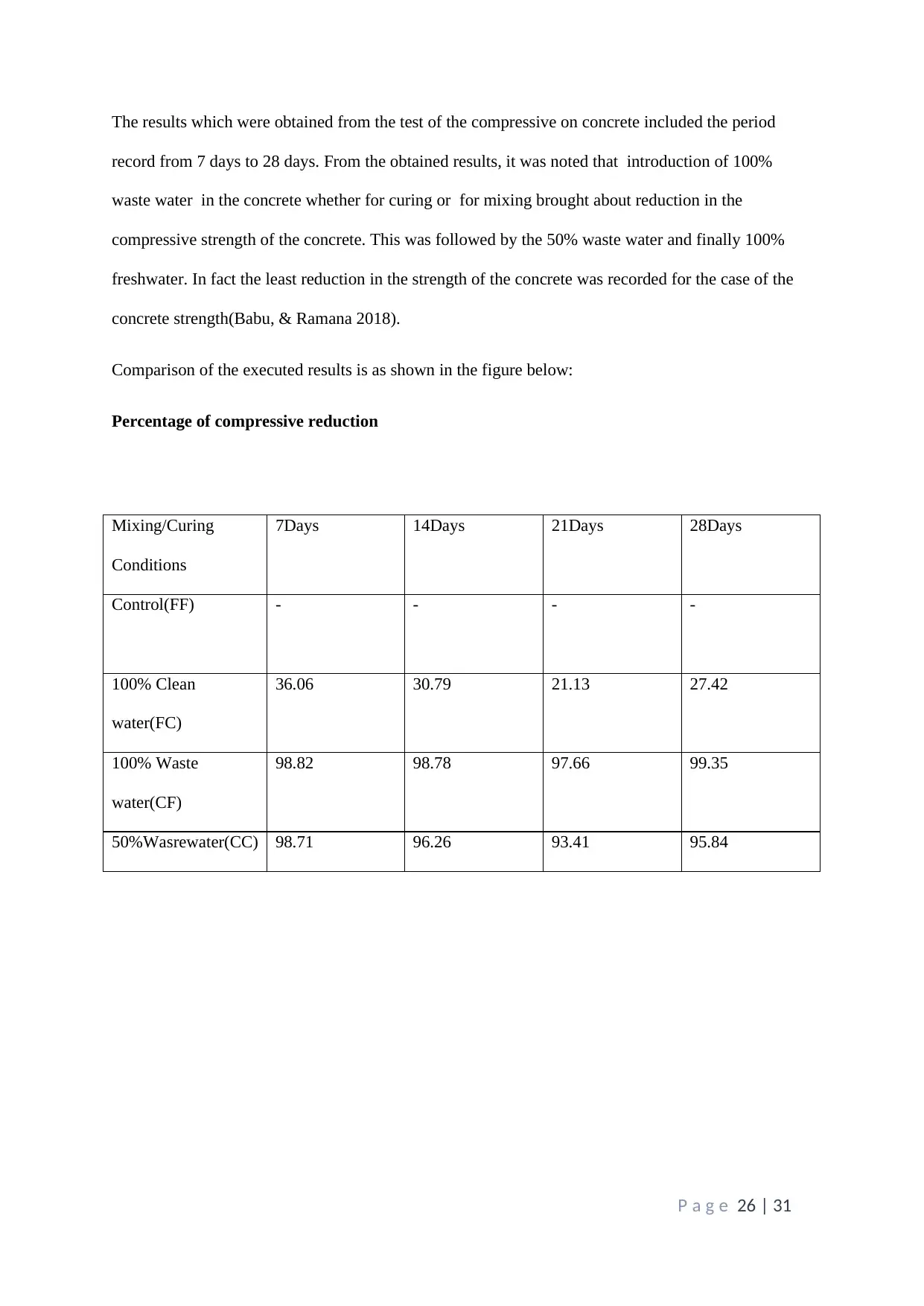
The results which were obtained from the test of the compressive on concrete included the period
record from 7 days to 28 days. From the obtained results, it was noted that introduction of 100%
waste water in the concrete whether for curing or for mixing brought about reduction in the
compressive strength of the concrete. This was followed by the 50% waste water and finally 100%
freshwater. In fact the least reduction in the strength of the concrete was recorded for the case of the
concrete strength(Babu, & Ramana 2018).
Comparison of the executed results is as shown in the figure below:
Percentage of compressive reduction
Mixing/Curing
Conditions
7Days 14Days 21Days 28Days
Control(FF) - - - -
100% Clean
water(FC)
36.06 30.79 21.13 27.42
100% Waste
water(CF)
98.82 98.78 97.66 99.35
50%Wasrewater(CC) 98.71 96.26 93.41 95.84
P a g e 26 | 31
record from 7 days to 28 days. From the obtained results, it was noted that introduction of 100%
waste water in the concrete whether for curing or for mixing brought about reduction in the
compressive strength of the concrete. This was followed by the 50% waste water and finally 100%
freshwater. In fact the least reduction in the strength of the concrete was recorded for the case of the
concrete strength(Babu, & Ramana 2018).
Comparison of the executed results is as shown in the figure below:
Percentage of compressive reduction
Mixing/Curing
Conditions
7Days 14Days 21Days 28Days
Control(FF) - - - -
100% Clean
water(FC)
36.06 30.79 21.13 27.42
100% Waste
water(CF)
98.82 98.78 97.66 99.35
50%Wasrewater(CC) 98.71 96.26 93.41 95.84
P a g e 26 | 31
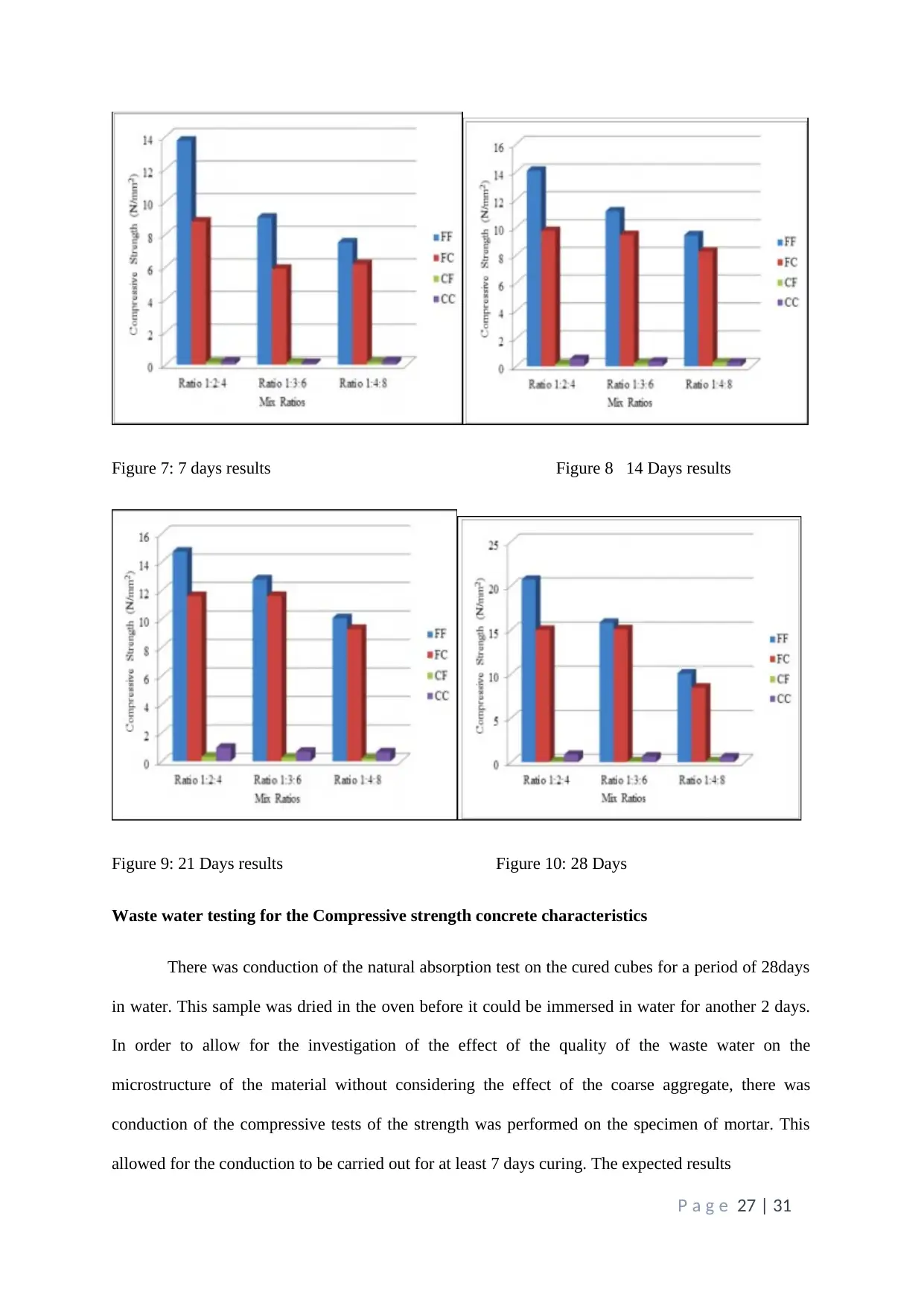
Figure 7: 7 days results Figure 8 14 Days results
Figure 9: 21 Days results Figure 10: 28 Days
Waste water testing for the Compressive strength concrete characteristics
There was conduction of the natural absorption test on the cured cubes for a period of 28days
in water. This sample was dried in the oven before it could be immersed in water for another 2 days.
In order to allow for the investigation of the effect of the quality of the waste water on the
microstructure of the material without considering the effect of the coarse aggregate, there was
conduction of the compressive tests of the strength was performed on the specimen of mortar. This
allowed for the conduction to be carried out for at least 7 days curing. The expected results
P a g e 27 | 31
Figure 9: 21 Days results Figure 10: 28 Days
Waste water testing for the Compressive strength concrete characteristics
There was conduction of the natural absorption test on the cured cubes for a period of 28days
in water. This sample was dried in the oven before it could be immersed in water for another 2 days.
In order to allow for the investigation of the effect of the quality of the waste water on the
microstructure of the material without considering the effect of the coarse aggregate, there was
conduction of the compressive tests of the strength was performed on the specimen of mortar. This
allowed for the conduction to be carried out for at least 7 days curing. The expected results
P a g e 27 | 31
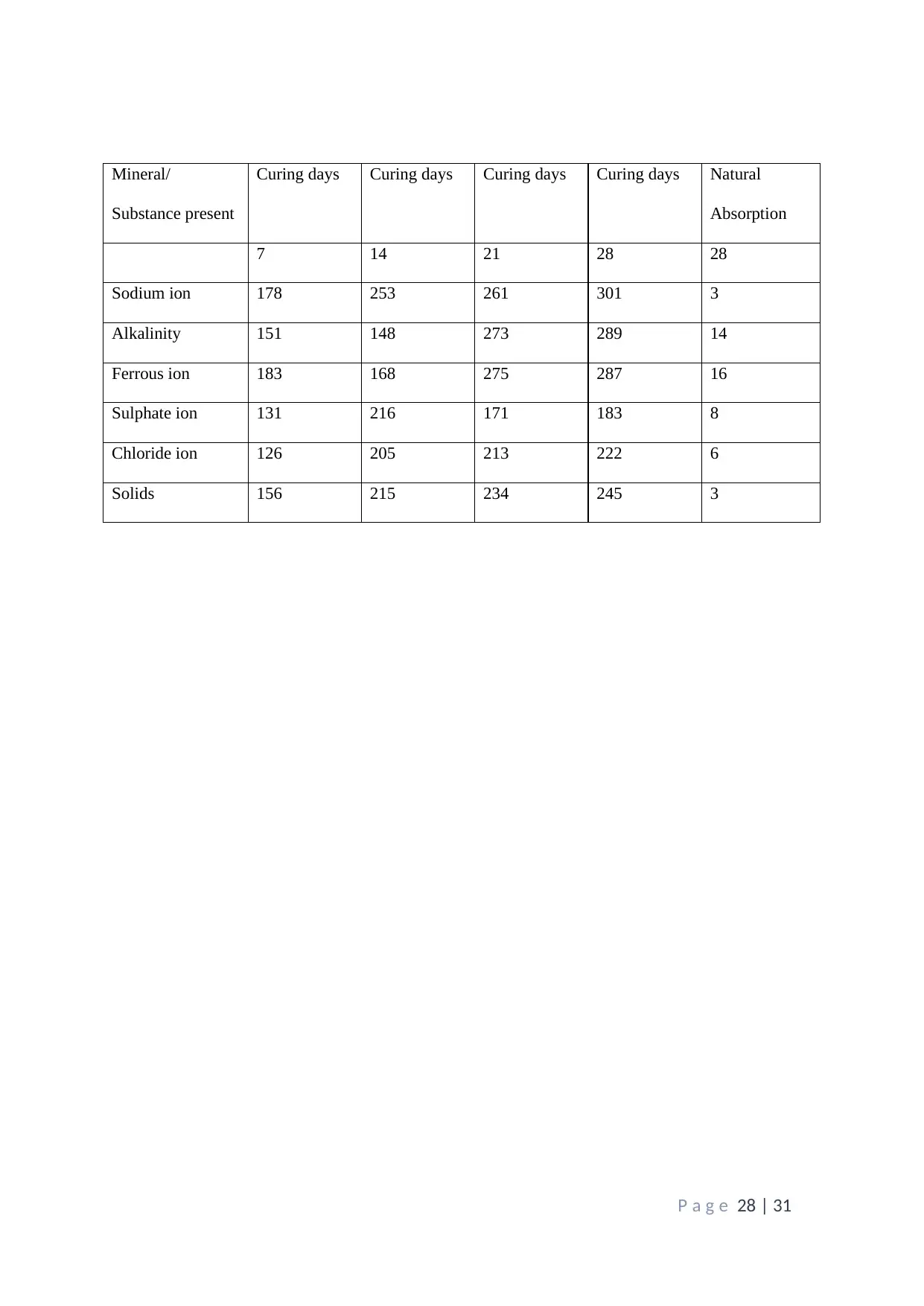
Mineral/
Substance present
Curing days Curing days Curing days Curing days Natural
Absorption
7 14 21 28 28
Sodium ion 178 253 261 301 3
Alkalinity 151 148 273 289 14
Ferrous ion 183 168 275 287 16
Sulphate ion 131 216 171 183 8
Chloride ion 126 205 213 222 6
Solids 156 215 234 245 3
P a g e 28 | 31
Substance present
Curing days Curing days Curing days Curing days Natural
Absorption
7 14 21 28 28
Sodium ion 178 253 261 301 3
Alkalinity 151 148 273 289 14
Ferrous ion 183 168 275 287 16
Sulphate ion 131 216 171 183 8
Chloride ion 126 205 213 222 6
Solids 156 215 234 245 3
P a g e 28 | 31
Secure Best Marks with AI Grader
Need help grading? Try our AI Grader for instant feedback on your assignments.

P a g e 29 | 31
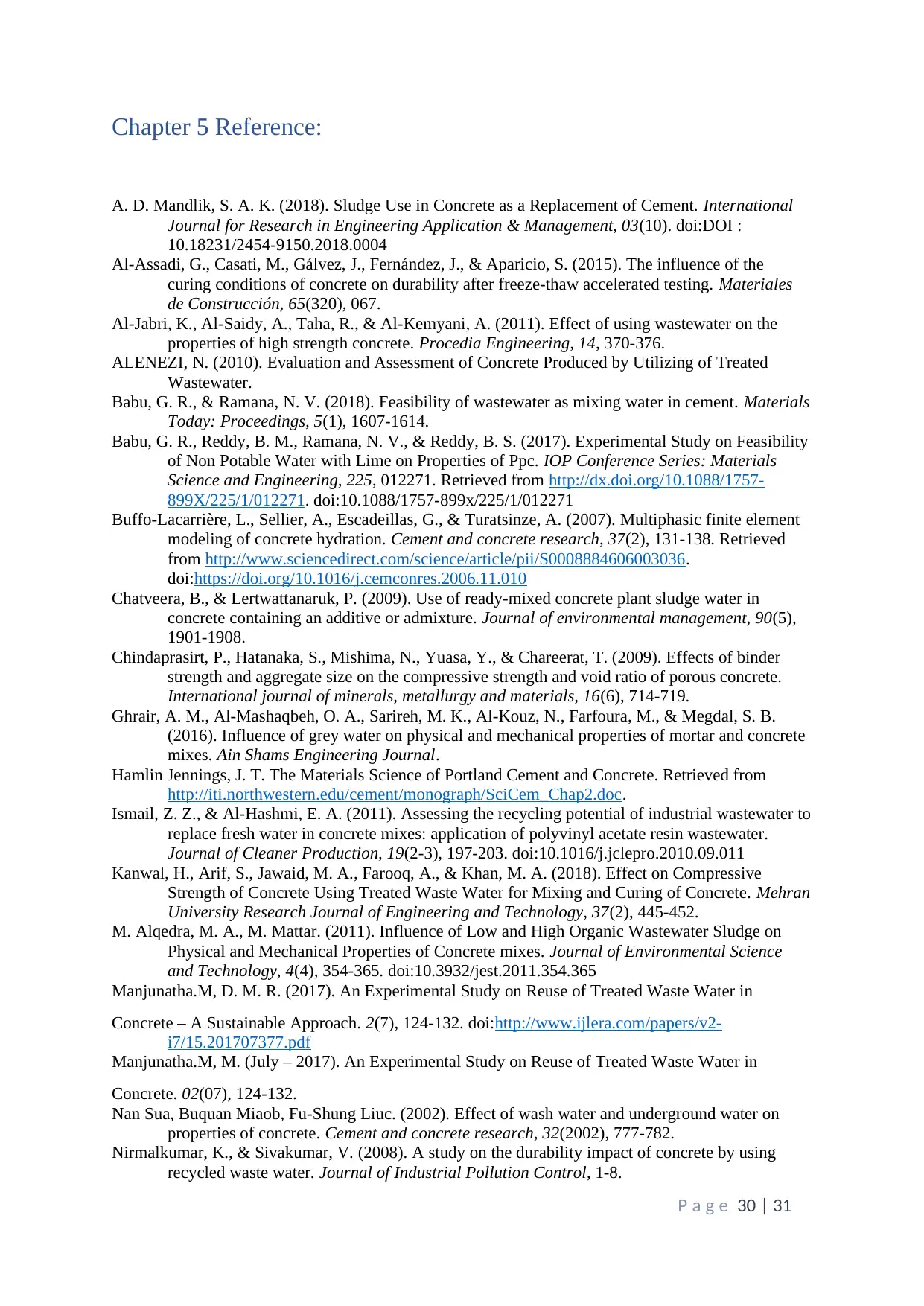
Chapter 5 Reference:
A. D. Mandlik, S. A. K. (2018). Sludge Use in Concrete as a Replacement of Cement. International
Journal for Research in Engineering Application & Management, 03(10). doi:DOI :
10.18231/2454-9150.2018.0004
Al-Assadi, G., Casati, M., Gálvez, J., Fernández, J., & Aparicio, S. (2015). The influence of the
curing conditions of concrete on durability after freeze-thaw accelerated testing. Materiales
de Construcción, 65(320), 067.
Al-Jabri, K., Al-Saidy, A., Taha, R., & Al-Kemyani, A. (2011). Effect of using wastewater on the
properties of high strength concrete. Procedia Engineering, 14, 370-376.
ALENEZI, N. (2010). Evaluation and Assessment of Concrete Produced by Utilizing of Treated
Wastewater.
Babu, G. R., & Ramana, N. V. (2018). Feasibility of wastewater as mixing water in cement. Materials
Today: Proceedings, 5(1), 1607-1614.
Babu, G. R., Reddy, B. M., Ramana, N. V., & Reddy, B. S. (2017). Experimental Study on Feasibility
of Non Potable Water with Lime on Properties of Ppc. IOP Conference Series: Materials
Science and Engineering, 225, 012271. Retrieved from http://dx.doi.org/10.1088/1757-
899X/225/1/012271. doi:10.1088/1757-899x/225/1/012271
Buffo-Lacarrière, L., Sellier, A., Escadeillas, G., & Turatsinze, A. (2007). Multiphasic finite element
modeling of concrete hydration. Cement and concrete research, 37(2), 131-138. Retrieved
from http://www.sciencedirect.com/science/article/pii/S0008884606003036.
doi:https://doi.org/10.1016/j.cemconres.2006.11.010
Chatveera, B., & Lertwattanaruk, P. (2009). Use of ready-mixed concrete plant sludge water in
concrete containing an additive or admixture. Journal of environmental management, 90(5),
1901-1908.
Chindaprasirt, P., Hatanaka, S., Mishima, N., Yuasa, Y., & Chareerat, T. (2009). Effects of binder
strength and aggregate size on the compressive strength and void ratio of porous concrete.
International journal of minerals, metallurgy and materials, 16(6), 714-719.
Ghrair, A. M., Al-Mashaqbeh, O. A., Sarireh, M. K., Al-Kouz, N., Farfoura, M., & Megdal, S. B.
(2016). Influence of grey water on physical and mechanical properties of mortar and concrete
mixes. Ain Shams Engineering Journal.
Hamlin Jennings, J. T. The Materials Science of Portland Cement and Concrete. Retrieved from
http://iti.northwestern.edu/cement/monograph/SciCem_Chap2.doc.
Ismail, Z. Z., & Al-Hashmi, E. A. (2011). Assessing the recycling potential of industrial wastewater to
replace fresh water in concrete mixes: application of polyvinyl acetate resin wastewater.
Journal of Cleaner Production, 19(2-3), 197-203. doi:10.1016/j.jclepro.2010.09.011
Kanwal, H., Arif, S., Jawaid, M. A., Farooq, A., & Khan, M. A. (2018). Effect on Compressive
Strength of Concrete Using Treated Waste Water for Mixing and Curing of Concrete. Mehran
University Research Journal of Engineering and Technology, 37(2), 445-452.
M. Alqedra, M. A., M. Mattar. (2011). Influence of Low and High Organic Wastewater Sludge on
Physical and Mechanical Properties of Concrete mixes. Journal of Environmental Science
and Technology, 4(4), 354-365. doi:10.3932/jest.2011.354.365
Manjunatha.M, D. M. R. (2017). An Experimental Study on Reuse of Treated Waste Water in
Concrete – A Sustainable Approach. 2(7), 124-132. doi:http://www.ijlera.com/papers/v2-
i7/15.201707377.pdf
Manjunatha.M, M. (July – 2017). An Experimental Study on Reuse of Treated Waste Water in
Concrete. 02(07), 124-132.
Nan Sua, Buquan Miaob, Fu-Shung Liuc. (2002). Effect of wash water and underground water on
properties of concrete. Cement and concrete research, 32(2002), 777-782.
Nirmalkumar, K., & Sivakumar, V. (2008). A study on the durability impact of concrete by using
recycled waste water. Journal of Industrial Pollution Control, 1-8.
P a g e 30 | 31
A. D. Mandlik, S. A. K. (2018). Sludge Use in Concrete as a Replacement of Cement. International
Journal for Research in Engineering Application & Management, 03(10). doi:DOI :
10.18231/2454-9150.2018.0004
Al-Assadi, G., Casati, M., Gálvez, J., Fernández, J., & Aparicio, S. (2015). The influence of the
curing conditions of concrete on durability after freeze-thaw accelerated testing. Materiales
de Construcción, 65(320), 067.
Al-Jabri, K., Al-Saidy, A., Taha, R., & Al-Kemyani, A. (2011). Effect of using wastewater on the
properties of high strength concrete. Procedia Engineering, 14, 370-376.
ALENEZI, N. (2010). Evaluation and Assessment of Concrete Produced by Utilizing of Treated
Wastewater.
Babu, G. R., & Ramana, N. V. (2018). Feasibility of wastewater as mixing water in cement. Materials
Today: Proceedings, 5(1), 1607-1614.
Babu, G. R., Reddy, B. M., Ramana, N. V., & Reddy, B. S. (2017). Experimental Study on Feasibility
of Non Potable Water with Lime on Properties of Ppc. IOP Conference Series: Materials
Science and Engineering, 225, 012271. Retrieved from http://dx.doi.org/10.1088/1757-
899X/225/1/012271. doi:10.1088/1757-899x/225/1/012271
Buffo-Lacarrière, L., Sellier, A., Escadeillas, G., & Turatsinze, A. (2007). Multiphasic finite element
modeling of concrete hydration. Cement and concrete research, 37(2), 131-138. Retrieved
from http://www.sciencedirect.com/science/article/pii/S0008884606003036.
doi:https://doi.org/10.1016/j.cemconres.2006.11.010
Chatveera, B., & Lertwattanaruk, P. (2009). Use of ready-mixed concrete plant sludge water in
concrete containing an additive or admixture. Journal of environmental management, 90(5),
1901-1908.
Chindaprasirt, P., Hatanaka, S., Mishima, N., Yuasa, Y., & Chareerat, T. (2009). Effects of binder
strength and aggregate size on the compressive strength and void ratio of porous concrete.
International journal of minerals, metallurgy and materials, 16(6), 714-719.
Ghrair, A. M., Al-Mashaqbeh, O. A., Sarireh, M. K., Al-Kouz, N., Farfoura, M., & Megdal, S. B.
(2016). Influence of grey water on physical and mechanical properties of mortar and concrete
mixes. Ain Shams Engineering Journal.
Hamlin Jennings, J. T. The Materials Science of Portland Cement and Concrete. Retrieved from
http://iti.northwestern.edu/cement/monograph/SciCem_Chap2.doc.
Ismail, Z. Z., & Al-Hashmi, E. A. (2011). Assessing the recycling potential of industrial wastewater to
replace fresh water in concrete mixes: application of polyvinyl acetate resin wastewater.
Journal of Cleaner Production, 19(2-3), 197-203. doi:10.1016/j.jclepro.2010.09.011
Kanwal, H., Arif, S., Jawaid, M. A., Farooq, A., & Khan, M. A. (2018). Effect on Compressive
Strength of Concrete Using Treated Waste Water for Mixing and Curing of Concrete. Mehran
University Research Journal of Engineering and Technology, 37(2), 445-452.
M. Alqedra, M. A., M. Mattar. (2011). Influence of Low and High Organic Wastewater Sludge on
Physical and Mechanical Properties of Concrete mixes. Journal of Environmental Science
and Technology, 4(4), 354-365. doi:10.3932/jest.2011.354.365
Manjunatha.M, D. M. R. (2017). An Experimental Study on Reuse of Treated Waste Water in
Concrete – A Sustainable Approach. 2(7), 124-132. doi:http://www.ijlera.com/papers/v2-
i7/15.201707377.pdf
Manjunatha.M, M. (July – 2017). An Experimental Study on Reuse of Treated Waste Water in
Concrete. 02(07), 124-132.
Nan Sua, Buquan Miaob, Fu-Shung Liuc. (2002). Effect of wash water and underground water on
properties of concrete. Cement and concrete research, 32(2002), 777-782.
Nirmalkumar, K., & Sivakumar, V. (2008). A study on the durability impact of concrete by using
recycled waste water. Journal of Industrial Pollution Control, 1-8.
P a g e 30 | 31
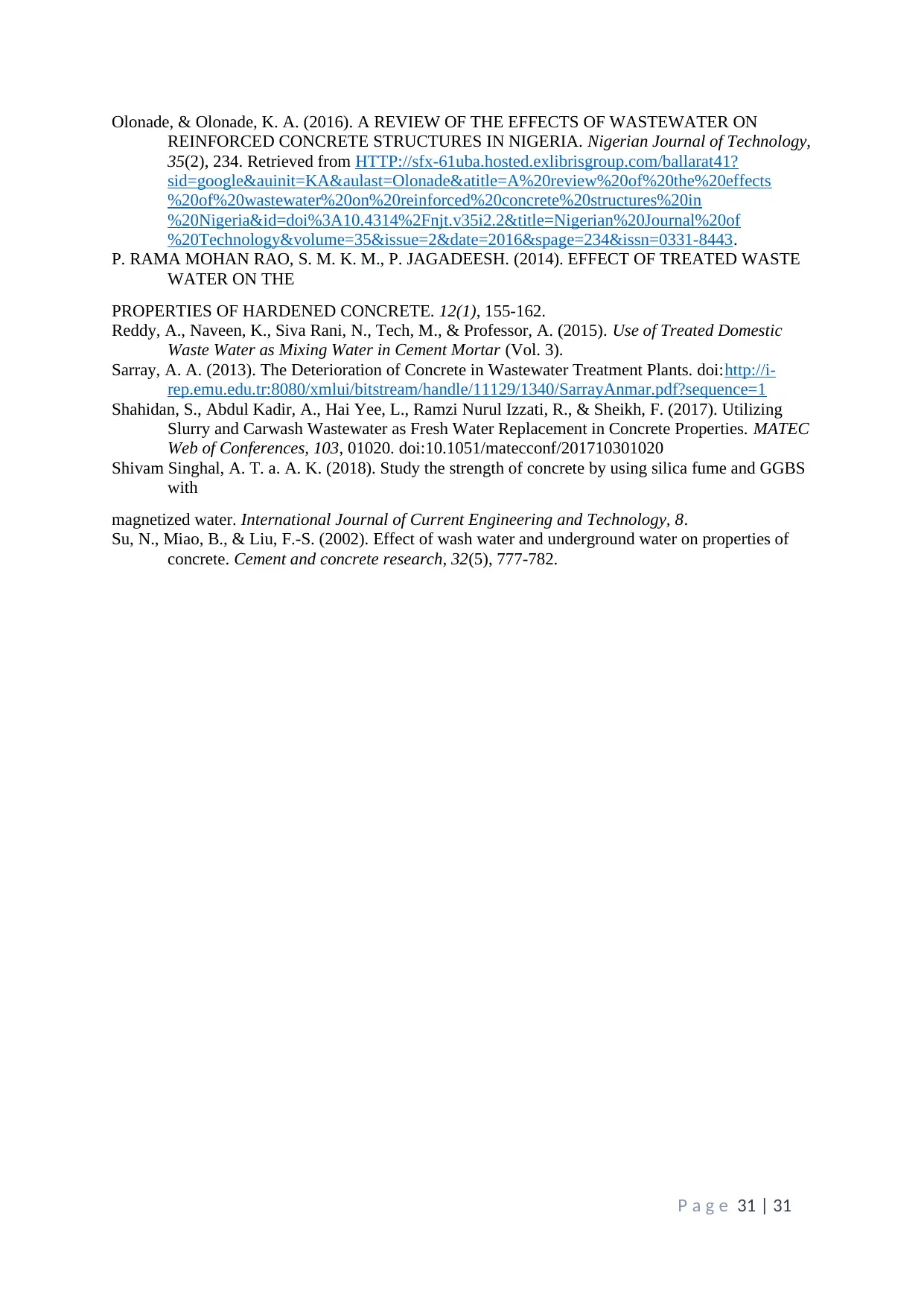
Olonade, & Olonade, K. A. (2016). A REVIEW OF THE EFFECTS OF WASTEWATER ON
REINFORCED CONCRETE STRUCTURES IN NIGERIA. Nigerian Journal of Technology,
35(2), 234. Retrieved from HTTP://sfx-61uba.hosted.exlibrisgroup.com/ballarat41?
sid=google&auinit=KA&aulast=Olonade&atitle=A%20review%20of%20the%20effects
%20of%20wastewater%20on%20reinforced%20concrete%20structures%20in
%20Nigeria&id=doi%3A10.4314%2Fnjt.v35i2.2&title=Nigerian%20Journal%20of
%20Technology&volume=35&issue=2&date=2016&spage=234&issn=0331-8443.
P. RAMA MOHAN RAO, S. M. K. M., P. JAGADEESH. (2014). EFFECT OF TREATED WASTE
WATER ON THE
PROPERTIES OF HARDENED CONCRETE. 12(1), 155-162.
Reddy, A., Naveen, K., Siva Rani, N., Tech, M., & Professor, A. (2015). Use of Treated Domestic
Waste Water as Mixing Water in Cement Mortar (Vol. 3).
Sarray, A. A. (2013). The Deterioration of Concrete in Wastewater Treatment Plants. doi:http://i-
rep.emu.edu.tr:8080/xmlui/bitstream/handle/11129/1340/SarrayAnmar.pdf?sequence=1
Shahidan, S., Abdul Kadir, A., Hai Yee, L., Ramzi Nurul Izzati, R., & Sheikh, F. (2017). Utilizing
Slurry and Carwash Wastewater as Fresh Water Replacement in Concrete Properties. MATEC
Web of Conferences, 103, 01020. doi:10.1051/matecconf/201710301020
Shivam Singhal, A. T. a. A. K. (2018). Study the strength of concrete by using silica fume and GGBS
with
magnetized water. International Journal of Current Engineering and Technology, 8.
Su, N., Miao, B., & Liu, F.-S. (2002). Effect of wash water and underground water on properties of
concrete. Cement and concrete research, 32(5), 777-782.
P a g e 31 | 31
REINFORCED CONCRETE STRUCTURES IN NIGERIA. Nigerian Journal of Technology,
35(2), 234. Retrieved from HTTP://sfx-61uba.hosted.exlibrisgroup.com/ballarat41?
sid=google&auinit=KA&aulast=Olonade&atitle=A%20review%20of%20the%20effects
%20of%20wastewater%20on%20reinforced%20concrete%20structures%20in
%20Nigeria&id=doi%3A10.4314%2Fnjt.v35i2.2&title=Nigerian%20Journal%20of
%20Technology&volume=35&issue=2&date=2016&spage=234&issn=0331-8443.
P. RAMA MOHAN RAO, S. M. K. M., P. JAGADEESH. (2014). EFFECT OF TREATED WASTE
WATER ON THE
PROPERTIES OF HARDENED CONCRETE. 12(1), 155-162.
Reddy, A., Naveen, K., Siva Rani, N., Tech, M., & Professor, A. (2015). Use of Treated Domestic
Waste Water as Mixing Water in Cement Mortar (Vol. 3).
Sarray, A. A. (2013). The Deterioration of Concrete in Wastewater Treatment Plants. doi:http://i-
rep.emu.edu.tr:8080/xmlui/bitstream/handle/11129/1340/SarrayAnmar.pdf?sequence=1
Shahidan, S., Abdul Kadir, A., Hai Yee, L., Ramzi Nurul Izzati, R., & Sheikh, F. (2017). Utilizing
Slurry and Carwash Wastewater as Fresh Water Replacement in Concrete Properties. MATEC
Web of Conferences, 103, 01020. doi:10.1051/matecconf/201710301020
Shivam Singhal, A. T. a. A. K. (2018). Study the strength of concrete by using silica fume and GGBS
with
magnetized water. International Journal of Current Engineering and Technology, 8.
Su, N., Miao, B., & Liu, F.-S. (2002). Effect of wash water and underground water on properties of
concrete. Cement and concrete research, 32(5), 777-782.
P a g e 31 | 31
1 out of 31
Your All-in-One AI-Powered Toolkit for Academic Success.
+13062052269
info@desklib.com
Available 24*7 on WhatsApp / Email
![[object Object]](/_next/static/media/star-bottom.7253800d.svg)
Unlock your academic potential
© 2024 | Zucol Services PVT LTD | All rights reserved.
